 US Navy Fleet Destroyers (1944-90): 104 vessels
US Navy Fleet Destroyers (1944-90): 104 vesselsThe Gearings were the last American destroyers of the war. They mirrored the Sumner specifications for armament, but with a new, longer hull for extra oil storage and extended range. The initial program included 116 ships but in the end, 106 were completed, roughly half in the last months of 1945, and few arrived in time for the last operations. They however saw extensive service in the Atlantic and Mediterrean postwar; They soldiered in Korea and most were modernized along the FRAM ASW upgrade also soldering in Vietnam, and later under other flags well into the 2000s. https://naval-encyclopedia.com/ww2/us/gearing-class-destroyers.php #ww2 #usnavy #gearingclass #destroyers #unitedstatesnavy

Development History
The very foundation of the Gearings is seen in the whole development of the Allen M Sumner class, so let’s resume matters here: In October 1941, the Bureau of Ships (BuShips) proposed a new destroyer design that could sport its new twin enclosed 5in/38 instead of the usual single mount. The compactness of the mount would bring not only an extra gun, but also reduced the crowded centerline, making way for extra AA. The General Board at the same time wanted a new heavy destroyer capable of better speed, and by 1942 proposed a 2500-tonner. However the Bureau of Ships proposed as interim to retake the same hull as the recent Fletcher class, same machinery, as a base to gain time and at least test the new weapons configuration.
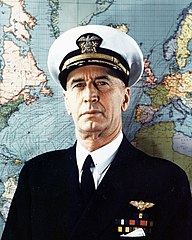 In early 1942, conferences held under CNO (Chief of Naval Operations) Adm. Ernest J. King, affirmed that forward firepower was the “most desirable main battery for a destroyer” and that ideally superfiring positions needed to be magnified. Two guns on the Fletcher’s forward section was thus too limited. The Fletcher design was then to be modified to accommodate with a slight increase in beam and displacement twin turrets forward (the aft section was even initially to keep three single mounts). This became the DD 692 class (Allen M. Sumners).
In early 1942, conferences held under CNO (Chief of Naval Operations) Adm. Ernest J. King, affirmed that forward firepower was the “most desirable main battery for a destroyer” and that ideally superfiring positions needed to be magnified. Two guns on the Fletcher’s forward section was thus too limited. The Fletcher design was then to be modified to accommodate with a slight increase in beam and displacement twin turrets forward (the aft section was even initially to keep three single mounts). This became the DD 692 class (Allen M. Sumners).
The admiralty loved the space offered by this new configuration and demanded more AA weapons stations, (in the end, 2 quadruple, 2 twin 40mm, 11-20mm AA) and the Sumner met the same overweight problem and ended even slower than the Fletchers, so more power was required to keep pace, reducing range further. All this appeared in 1943, prompting a modification that became the Gearing design. The new design also incorporated another park, the unpopular enclosed Admiralty-style bridge, for a new mixed open and close bridge, which was also retroactively applied to the late production Sumner and all Gearings from the start. In short, this bridge was open, with its enclosed section in its center.

The difference between classes in a nutshell: The added section makes the funnels looks further apart.
So essentially, the Gearings were a minor modification of the Allen M. Sumner class with the hull lengthened by 14 ft (4.3 m) in the amidships section, so to carry more fuel storage space, increasing operating range. This was its main raison d’être. Later the Gearing DD 710 class was just called internally the “extended-hull variant” but both Sumner-Gearings were called the 2,200-tonners, and sub-differentiated as “short hulls” and “long hulls.” Internal subdivision was improved, but no other changes were undertaken so to allow all yards already building the Sumners to swap on the new design in no time. It was still hoped that the Gearings could be operational by wartime.
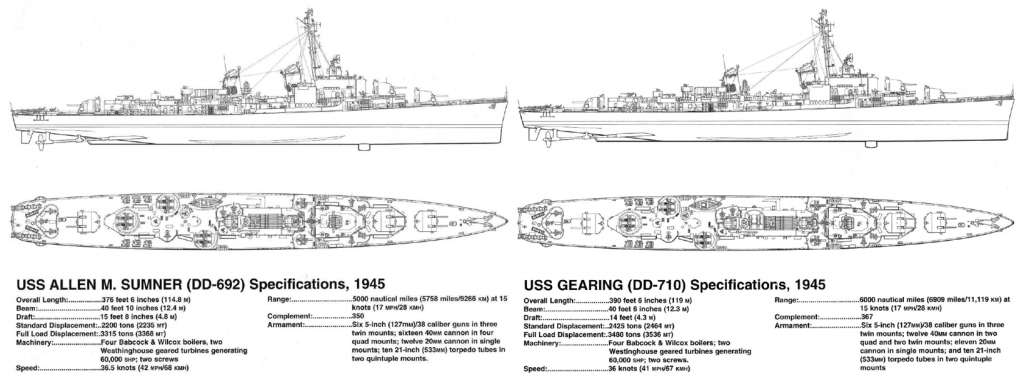
Sumner and Gearing class side by side
Design of the class
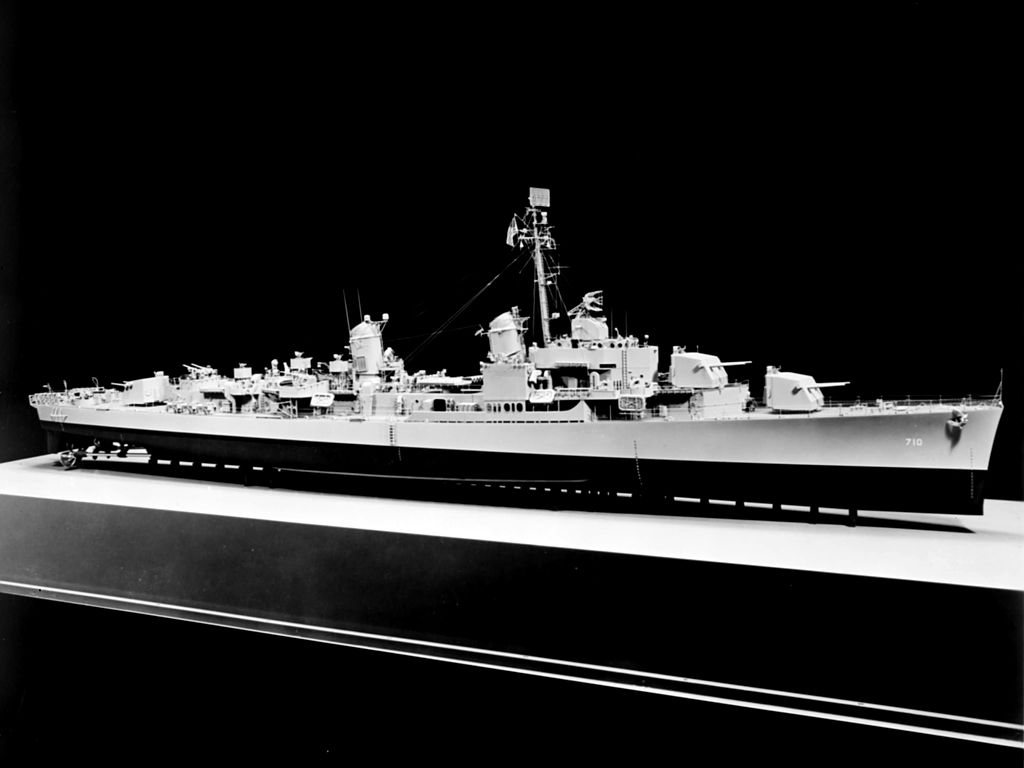
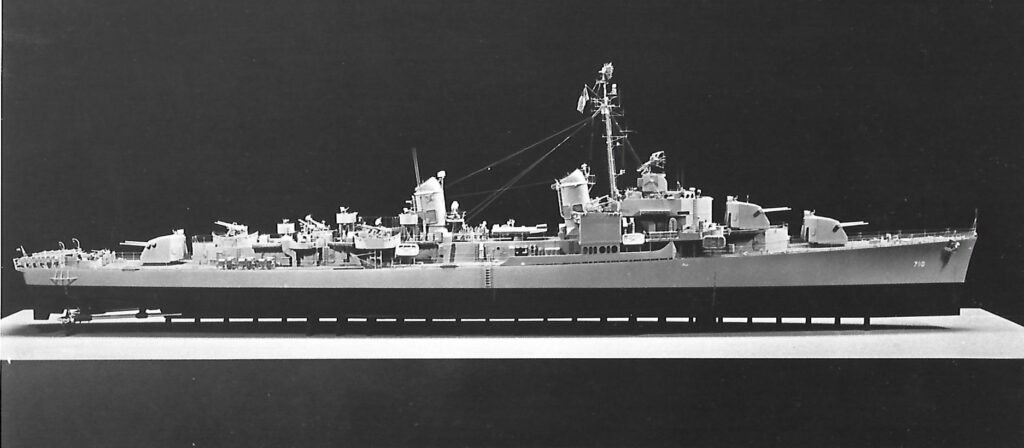
Gibb & Cox 1948 model of the USS Gearing
Hull and general design

USS Chevalier
The Gearing class was a “stretched” Sumner amidships, of 14 ft (4.3 m), to that the general proportions looked utterly similar, without changes at the prow and stern. Only the funnels looked a bit further apart. This lenghtening of an entire section also added extra rooms in the superstructures, freeing a bit more space albeit the rest of the ship was a pure copy of the previous design in all details to gain time.
No need so to spent time describing the design in detail as it was well treated in the Sumner class article. It should just be underlined that unlike the later, the Gearing class had a new open bridge from the start, and thus, no sub-class. The open bridge was a platform completely surrounding a small, narrow bridge which supported the main fire control system. As usual, this bridge was dotted with portholes for contruction simplification. This bridge was also completed aft with two large wings supporting AA guns, twin Bofors mounts. Combined with the bulwark’s enclosures, it protected well the aft deck from water spray. It was necessary as due to internal bulkheads, communication inside the ship were impossible from bow to stern without accessing the weather deck.
Powerplant
This was essentially the same as the Sumner class: Four General Electric steam turbines, composed of a high pressure and low pressure unit, fed by fourboilers, two in separate room for each one, for a total of 60,000 shp (45,000 kW). The shaftss and struts, propellers, rudder, were all identical to the Sumner and in straight line closely derived from the Fletcher class.
Top speed achieved was 36.8 kn (68.2 km/h; 42.3 mph) instead of 38 knots, but at that stage in the war, when naval duels were unlikely, this was less of an issue. This was amply compensated by the added fuel: 740 tonnes instead of 379 tonnes, giving the Gearings a total of 4,500 nmi (8,300 km; 5,200 mi) at 20 knots (37 km/h; 23 mph) instead of 3,300 nm at 20 knots, so a good 1/3 improvement.
In many ways, there are strong parallels between the Wickes-Clemsons of WWI and the Sumner-Gearing of WW2, they were both wartime design twins modified for the sake of more range.
Armament
Main
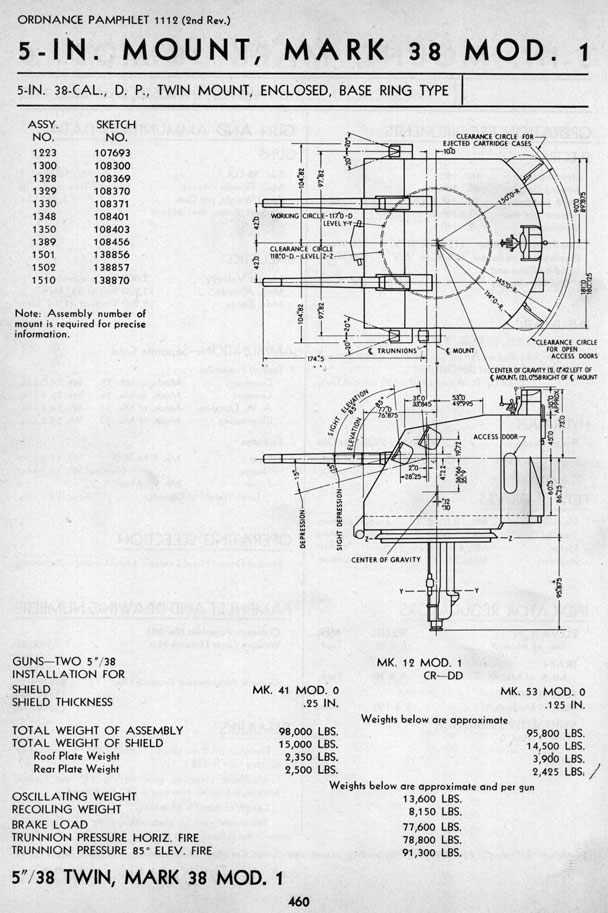
Placed for forward combat with two turrets superfiring forward (the N°2 caused stability concerns) and a single on the deck aft. They were the first time a twin turret was fitted on a US destroyers, since the Destroyer leaders of the Porter and Porter class which had a anti-ship mounts Mark 22 instead. The new Mark 12 was more compact but taller due to the high angle reload system enabling a great rate of fire. After the top edge fire control system which made these arguably the best dual purpose guns of WW2, using proximity fuses was another enormous advantage.
The turrets ended on any ship of the Navy from the destroyer to up level, light, AA, heavy cruisers, battleships and aircraft carriers. This was the great standard also used by the RN and for which untold quantities of rounds were turned by US factories. The stockpile in the billions was such that it could continue to feed arsenals using these ships, even modernized around the globe, until the very end of the cold war !
In Europe for example, all NATO navies used this caliber for decades, including for their own domestic destroyers, except Britain. Spain, Italy, France and West Germany, but also Greece Turkey, the Netherlands, etc.
Each turret had two Mark 12 guns, on a Mark 38 Mod 1 and Mod 2 (Sumner and Gearing respectively), weighting for the Mark 38 Mod 0, 95,700 lbs so the weight of a heavy tank.
However on destroyers if similar in design these mounts differed by having a much lighter construction but thinner shield. The also had simpler case deflection chutes in case of ejection chutes.
⚙ specifications Mark 12 gun |
|
| Twin Mount Weight (Mk.38 mod0) | 95,700 lbs. (43,409 kg) |
| Shell | 20 × 110 mm RB. HE 123 g (4.3 oz), HE/T: 116 g (4.1 oz) |
| Muzzle velocity | 820 m/s (2,700 ft/s) |
| Rate of fire | Max 450, Practical 250-320, cyclic 900 rpm |
| Range | Effective 914 m (1,000 yd), max 45° 4,389 m (4,800 yd) |
| Elevation | -15/+85 degrees (30° train, 15° elevat./sec.) |
| Protection | Mod 0: 0.125 in (0.32 cm) |
| Crew | 9 |
Anti-Aicraft Battery
2″/50 Bofors (40 mm) Mark 12, Mark 2/4 quad, Mark 1 Twin
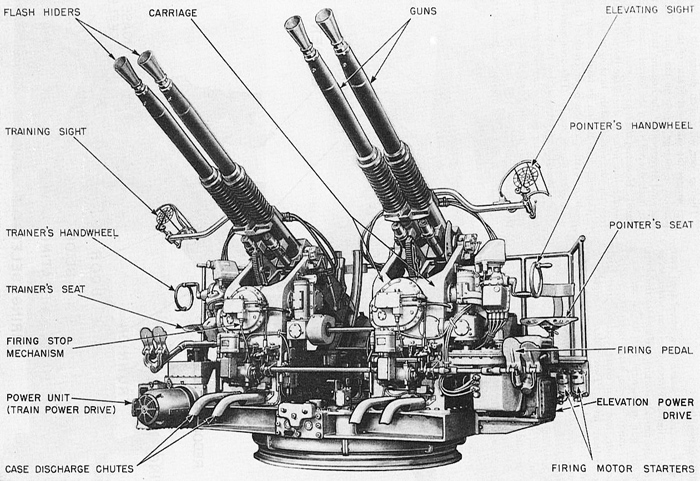
ONI 40 mm quad Bofors sheet
These models derived from the originals made by Swedish AB Bofors in the 1930s, and they were soon adopted by the US for mass production under its own patterns, with many improvements, deriving from earlier British models. Chrysler made 60,000 guns, 120,000 barrels at half the original projected cost. On the Sumner and Gearing class, as well as the modified Fletchers, they were available in both quad and twin mounts.
The former was the MK 12 quadruple mount, provided as standard with 2,000 rounds per barrel. Barrel life was c9,500 Rounds.
Mount: Mark 4 quad: Weight 22,795 – 24,553 lbs (10,340 – 11,137 kg), elevation -15/+90 (rate 55°/sec) train 50°/sec.
Crew: five men, gun commander, two gunners, two loaders. Recoil 7.9 in (20 cm)
RPM: 16-round bursts cycles, up to 120 rpm with a well-trained crew.
Round: 900 g (2.0 lb) HE 40×311R (rimmed) shell, 2,960 ft/s (900 m/s), penetration 4,000 yards (3,658 m): 0.60″ (15 mm)
Range: 7,200 m (23,600 ft), max practicable 3,800 m (12,500 ft), but max 22,800 feet (6,949 m) at 90°.

Both twin and quads mounts shared the water-cooled Mark 1 and Mark 2 Bofors guns. The quads were two twin mounts joined together, each pair had a left-hand gun Mark 1, right-hand gun Mark 2. The pairs were 60.0 in (1.524 m) apart. Elevation motors: 5 hp, training motors: 5/7.5 hp, Hydraulic drive gear. Fired using a delay gear to reduce inbalance and dispersion. In all, 2,300 quad mounts were provided to the Navy. More
1.1-in/70 Oerlikon (20 mm) single Mark

20 mm Oerlikon gun
Going back to Luftstreitkräfte planes gun project from 1918, took on in the interwar was Seebach Maschinenbau Aktien Gesellschaft of Zürich (SEMAG) into the 1935 into the FF, FFL and FFS family, licenced to Hispano-Suiza, Ikaria and others. The ship base Oerlikon SS (1938) was adopted and licenced, towards the 1SS of 1942, and 2SS from 1945 on the Gearing class. Coupled with the electric Mark 14 gunsight which triangulated an aiming point on a fast-flying aircraft using two gyro stabilization systems. These single mounts were shielded. Provision was four on the Benhams, Fletcher, bu it went to eleven for the Sumner and Gearing classes due their larger useful deck space and design modifications. This changed little as the war progressed due to the short time involved and because the Bofors was clearly preferred by the summer of 1945 with the “kamikaze onslaught” which decimated Fletcher class ships in particular in picket duty off Okinawa.
On the Sumner class, these eleven 1,695 lbs. (769 kg) mount Mark 4, 70 caliber (0.79″) were located xxxx
They had a Cyclic RPM of 450 rounds per minute, but practical 250-320 rounds, for a range of 3,840 feet (1,170 m) at 35° and up to 8,000 m max theoretical at 85° (-5/+87 degrees).
Elevation and traverse were manual, the gunner having shoulder pads encompassing his forearm to use the whole upper body. Legs were generally rarely moved except when following a low passing-by “bogey”.
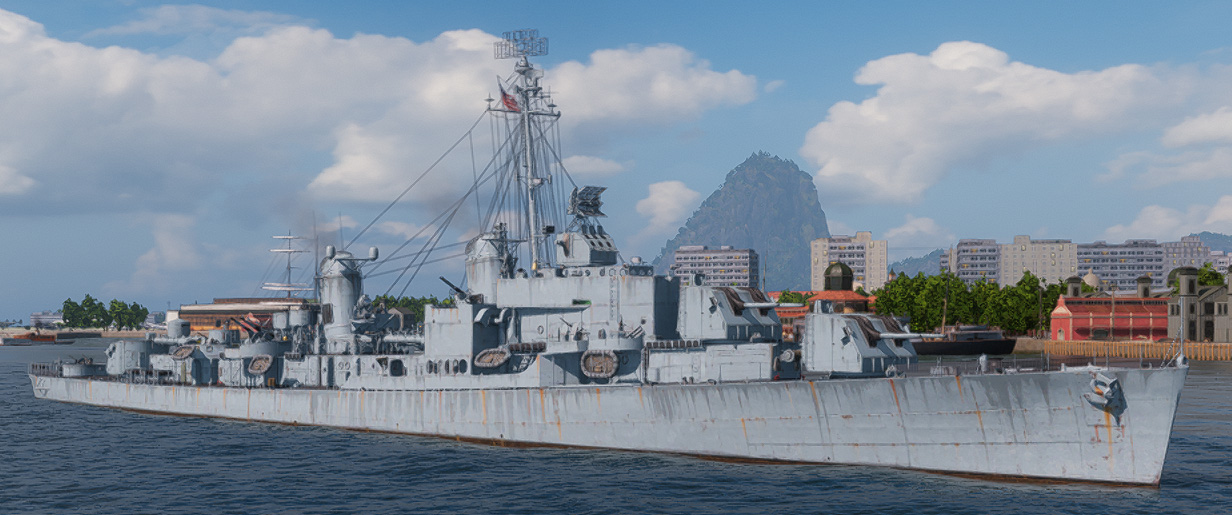

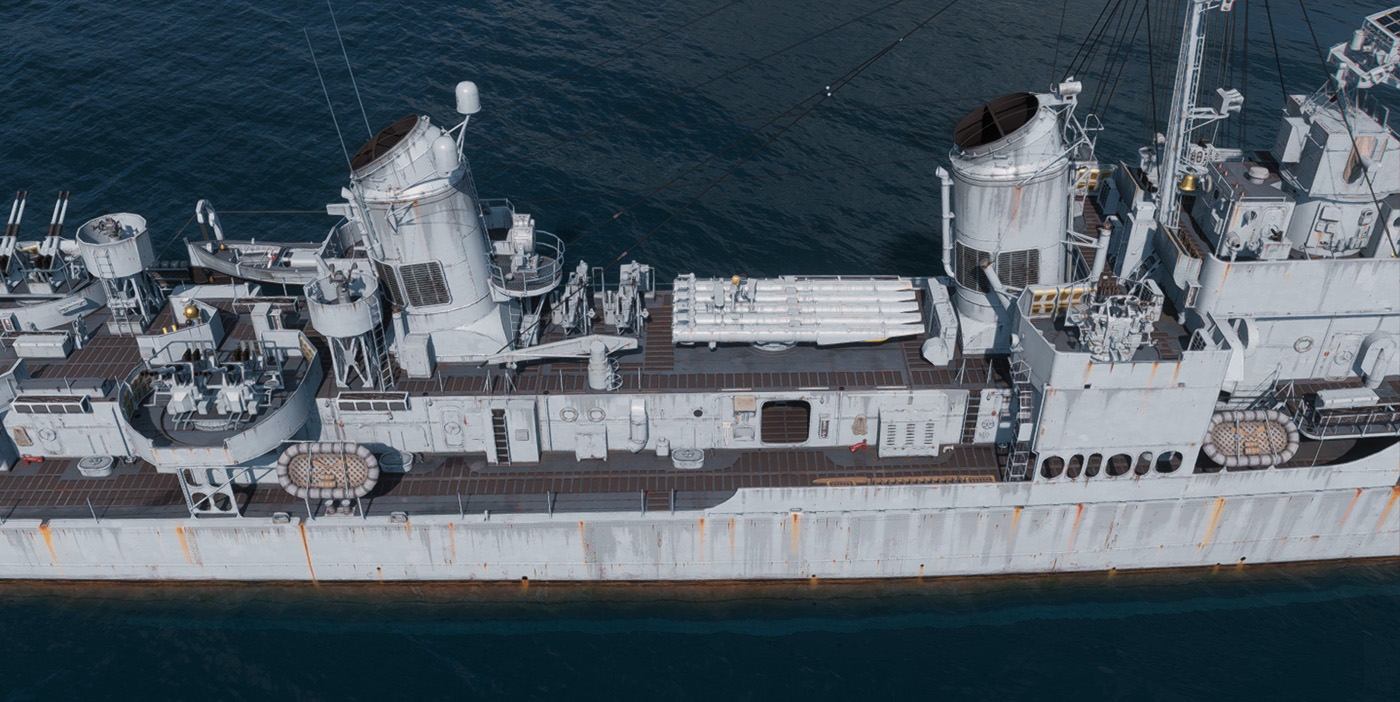
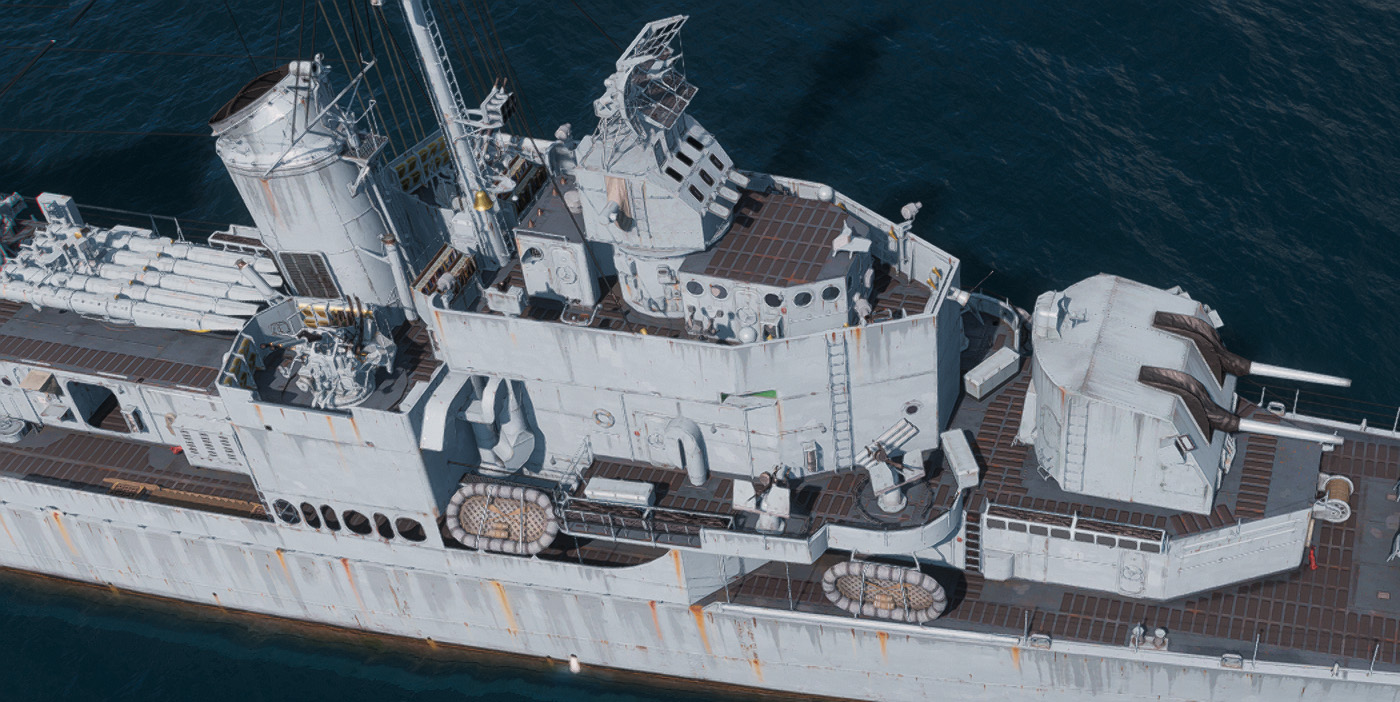
Details of the class (here, Gearing class).
Torpedo Tubes
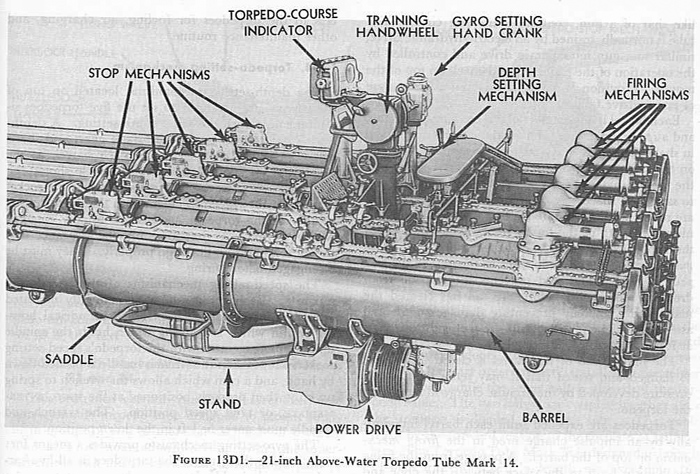
ONI explanation on the Mark 14 Quintuple Bank of the Benson-Gleaves (from navweaps).
The adoption of two axial quintuple banks was a repeat of the Sumner. Both were elevated out of water spray and placed in unusual locations: One was placed behind the first funnel, but the second was relegated to the aftermost part of the quarterdeck house, in place of former single main guns mounts on the Fletchers. This way, the greater beam amidship could be used to stack extra AA mounts, preferrably large quad ones. Since FY1938 the admiralty all all torpedo tubes on the centreline (this started with the Besons/Gleaves), raised well above the deck and with loading cranes and spare torpedoes. The paper tactic of the “scissors fire” (curve-ahead fire) was dropped as the need to preseve torpedo firepower.
The use of quintuple torpedo tube bank also maintained the status of US destroyers as leading the pack in terms of firepower. The European norm was two triple, later two quad banks sometimes in broadside. The Japanese at the time typically had three triple banks, making for nine torpedo broadside but with an efficient, quick reload system. The Gearing might had 10 or 14 reloads depending on sources, stored close to the banks, but the reload operations was risky and long, and needed to be done in calm seas. In practice in wartime, it was never done but at port. See a color rendition of the mount.
The MK 15 torpedo tube mounts were capable of launching the 21-inch MK 15 torpedo. The trainable, quintuple arrangement was derived from the quadruple bank, but with a larger base. Each mount comprises a stand, saddle, barrels, controls, heating equipment, and the caracteristic rounded blast shield on the MK 15 mount only. The latter was was installed to protect the crew from nearby 5-inch gun blast but the rest was were identical between the two Marks. Stand and saddle were equivalent of a base ring/carriage for a standard gun mount. The first was bolted to the deck, housing the training circle and bearings for the saddle.
The latter supported five barrels in a parallel arrangement, secured via hold down clips. Barrel assemblies comprised the main barrel, door and spoon extension bolted to the saddle via ring flanges. Doors aft (breech end) were hinged. Spoon extensions forward were also hinged, folding backwards on top of the barrel for better access to the torpedo warhead. Controls of the torpedo gyro and accesss to the depth and speed settings were fitted atop the barrels, aft of the ring flanges. They were electrically input. There were also two rows of barrel heaters underside close to the torpedo mechanisms as de-icing implement in cold weather.
The firing mechanism on top of each tube was located on aft end forward of the breech doors. They were launched individually by ignition of black powder from impulse cartridges that were to be replaced each time, fired either by hydraulic percussion or electrically. They were re-trigerred by a tripping latch after the torpedo left the muzzle.
Each Benson class ship has a pair of retractable loading cranes (one for each bank) and chain fall holding the torpedo to be aligned with the tube when reloaded, then manually pushed into the tube.
The while operation was too long and needed too pristine conditions to be carried out in the heat of battle.
⚙ 21-inch MK 15 Mod 3 torpedoes specs |
|
| Weight | 3,841 lbs. (1,742 kg) |
| Lenght | 24 ft (7.315 m) |
| Settings | 4,500 yds/45 kts – 9,000 yds/33.5 kts – 14,000 yds/26.5 kts |
| Propulsion | Wet-Heater steam turbine |
| Warhead | 801 lbs. (363 kg) TNT or 823 lbs. (373 kg) HBX |
| Exploder | Contact |
| Guidance | Mark 12 Mod 3 gyro |
| Reloads | Bensons: 0 to 4 |
ASW Armament
Mark 9 depth charges:
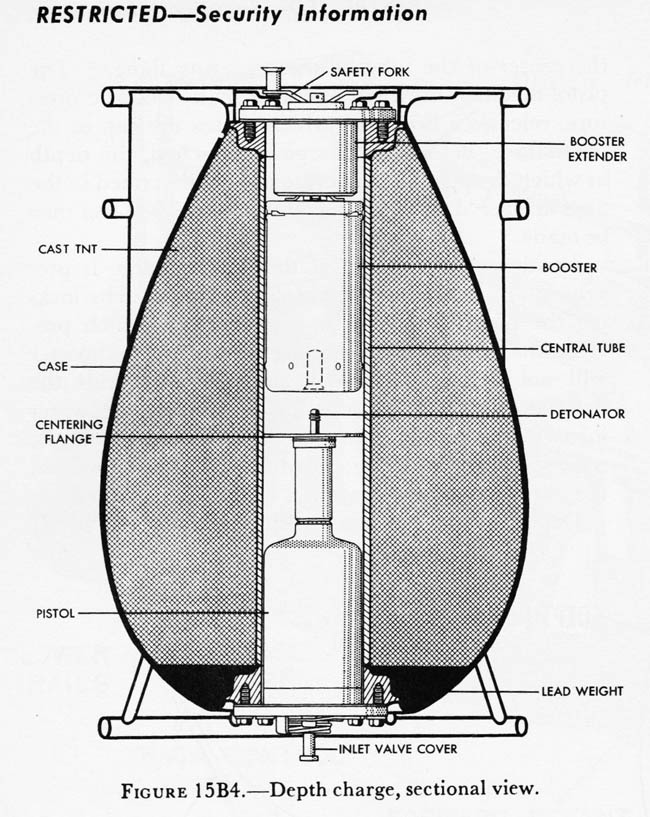
Standard-issue, reliable model from 1943 to 1945, evolution of the Mark 7 with “teardrop” shape for greater sink rate, and more accuracy. Mod 2: 1,000 feet (305 m), Torpex and spoiler plates to brake their rate of sink, but no on the Sumners which were fast enough to avoid the bast damage radius.
Mod 0, 1 and 2, weight 320 lbs./145 kg, or 320 lbs./145 kg and 340 lbs. (154 kg), 200 lbs. (91 kg) warhead, TNT or 190 lbs. (86 kg) Mod 2. torpex. Same Settings as for the Mark 7, 50-300 feet (15-91 m) or 600 feet (183 m).
K Guns Mark 6
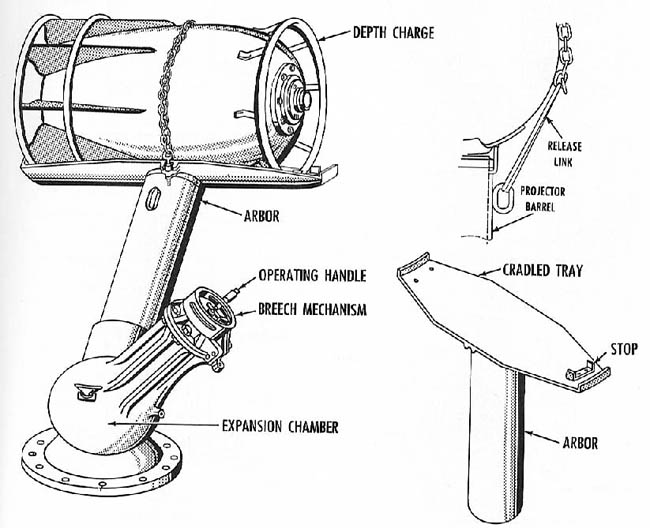
The USN standard Depth Charge Thrower (DCT), Mark 9 “K-gun” capable of 60 to 150 yards (55 to 137 m) in just 3.4 to 5.1 seconds. Placed in three systems aft on deck abaft the deckhouse.
The charges were 65 lbs. (29.5 kg) with increasing range, using black powder (settings 60, 90 and 150 yards (55, 82 and 137 m).
Sensors
Mk37 GFCS:
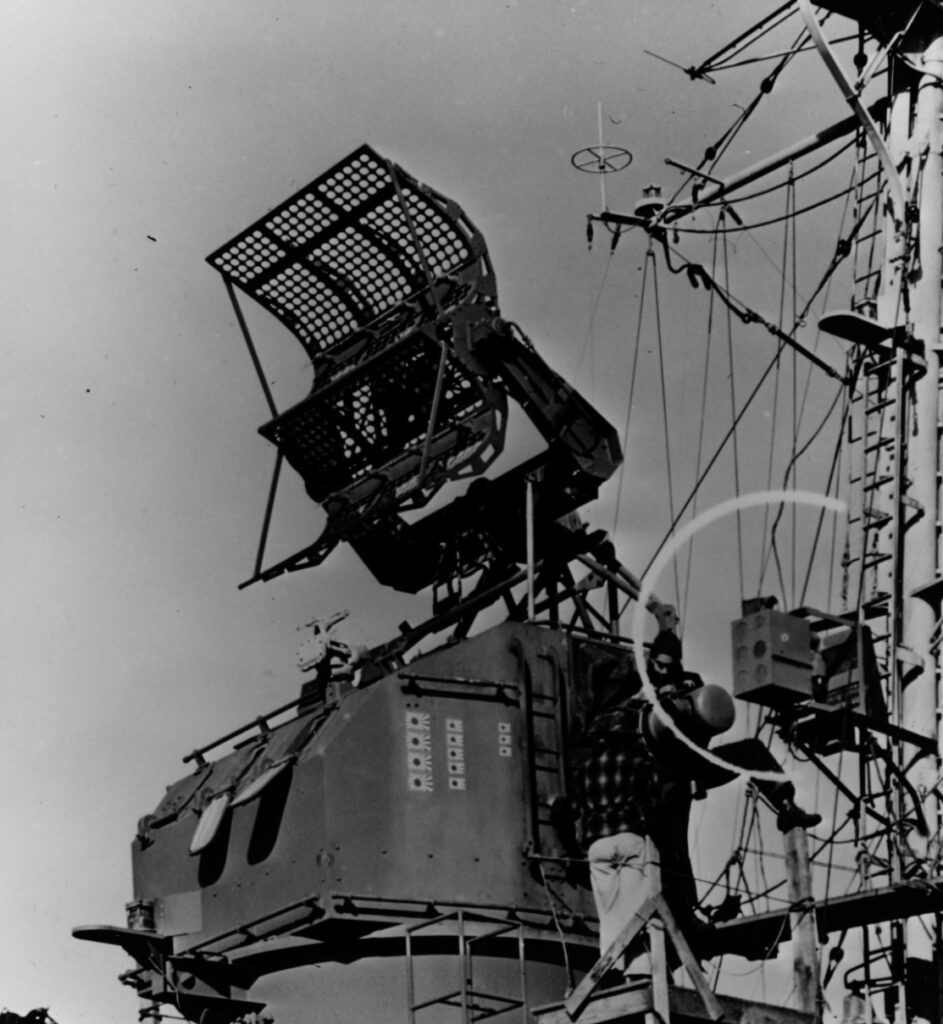
The Gearings were given the depedable and now mature, radar-assisted Mark 37 director. This 8,000 pounds (3,600 kg) fully enclosed director was heavier than the Mark 36 but had greater reliability, improved performance for the 5-inch guns especially in antiaircraft use. As for previous ships, the sensitive computer was installed below deck with a full CiC. On top of the small bridge, it was topped by a radar. At close-in ranges accuracy fell off however. The computer was the elderly Ford Mark 1, which combined with the VT proximity fuze increased hit probabilities.
SC radar:
This 220 kW standard air surveillance radar (1942), Air but also Surface-search model worked on VHF band with a PRF of 60 Hz, a Beamwidth of 10–25°, Pulsewidth of 4–5 μs, Range of 48–120 km (30–75 mi) with a precision of 90–180 m (98–197 yd). It was installed on top of the pole mainmast.
SG radar:
Tested on the destroyers USS Semmes in May 1941 it became the standard surface-search aerial. 955 of these 50 kW unit were built. They worked at the 3 GHz frequency, with a PRF of 775, 800, or 825
and Beamwidth of 5.6° (horizontal) and 15° (vertical), a Pulsewidth of 1.3–2 μs, 4, 8, or 12 rpm. Range was 15 nmi (28 km; 17 mi) with a 200 yd (180 m) precision.
12.22 radar:
This one was combined with the Mark 37 director.
QGA sonar
Block diagram of the QGA system.
The QGA was a searchlight sonar system designed for installation on destroyers. The system has two complete sonar equipments that are practically identical. One operates on a frequency of 14 kc; the other, on a frequency of 30 kc. The 30-kc transducer can be tilted downward from an angle of 0° to an angle of 45° below the deck. This feature is of value when the sonar vessel is approaching a deep target. The QGA consoles are similar to the QGB console. They are installed side by side in the sonar control room. The two equipments of the QGA are capable of independent operation, or they may be slaved by a control on the 14-kc console. External tactical recorder can be used to control the transmission of either equipment or both of them.
The receiving system for each console consists of an audio receiver and a BDI receiver. The transmitters are conventional r-f amplifiers. A unicontrol-oscillator system tunes the receivers and transmitter of each unit.
The magnetostriction transducers are mounted on concentric shafts that are hoisted and lowered together. The 30-kc transducer is smaller because of its higher frequency. It is mounted over the 14-kc transducer. The training mechanisms are arranged so that the transducers can be trained independently of each other. src See also
Construction and Modifications
There were in all some 152 “long-hull Sumners” ordered. 98 were completed, including 45 before the end of WW2. At Bath Iron Works, USS Frank Knox and USS Southerland were numbered in sequence and launched without pause in production schedule, right after after the last Allen M. Sumner, USS Drexler at this yard. commissioned in 1944. 62 were commissioned by the end of 1945, 91 until 1946, and two more (USS Lloyd Thomas, Keppler) by 1947, four (USS Epperson, Basilone, Carpenter and Robert A. Owens with intensive ASW modifications in 1949; The very last Gearing was USS Timmerman which tested a new experimental engineering plant, and she was really commissioned in… 1952. Seven were canceled by presidential veto. Keels for the remaining 47 (DD 809–816, 854–856 and 891–926) were never laid down and also cancelled in 1945.
The Navy under ordered of Admiral King was also forced to convert 24 Gearings as radar picket ships (DDR by 1949) to provide early warning in advanced of Kamikaze formations, planned for Operation Olympic in early 1946. They had to be given also an updated Combat Information Center and better communication sets. Twelve just completed destroyers were chosen (DDs 742–3, 805–8, 829 and 873–77) in January 1945 and twelve more in May 1945 (DDs 830–35 and 878–83), converted at Boston or Norfolk. Theit forward torpedo tube mount was removed and replaced by a new tripod mast supporting a dedicated height-finding radar notably. This was found very effective in exercizes, so 11 more were so converted in 1952–53.
The very first of these pickets only arrived by late June with the fast carrier task forces, in time for the final home island air raids and USS Frank Knox, Southerland and Perkins entered Tokyo Bay for the surrender. Unlike previous destroyers detached for this task (Sumner and Fletchers), they experienced no combat losses.
It should be noted that the assignation as radar picket was a dreaded prospect for any captain and crew of a destroyer, even the well armed Sumner. Most of the latter’s losses were attributed to this duties. A destroyer alone indeed stood little chance against a kamikaze formation. But they used their standard radars, which range was limited. In the case of the new DDRs, the centimetric radar decupled this range, so the picket had all time to join back the formation if needed.
Appearance
The Gearing class entered service in the dying months or days of WW2. So if the camouflage patterns were limited at that stage, at meast three had been identified: Measure 33a/28D wavy pattern (USS Frank Knox, see below) which was rare, the very common measure 22 graded system (nearly all), and the all dark ocean blue, measure 21, also rare.

Old author’s profile: Appearance of the Gearing class in January 1945 (entry into service), author’s illustration.
⚙ Gearing class specifications |
|
| Displacement | 2,616 long tons standard, 3,460 long tons full load |
| Dimensions | 390.5 x 40.9 x 14.3ft (119 x 12.5 x 4.4m) |
| Propulsion | 2 shaft GE turbines, 4 Babcock & Wilcox boilers, 60,000 hp. |
| Speed | 36.8 knots (68.2 km/h; 42.3 mph) |
| Range | Oil 379-504t, 3,300 nm/20 kts |
| Armament | 3×2 5-in/38, 2×4, 2×2 40mm, 11x 20mm AA, 2×5 533 mm TTs, 4 DC, 2 DCT |
| Protection | 0.5 in machinery deck, bridge, 0.7 in belt |
| Sensor | Mark 37 gun director, SC radar, QGA sonar, later SG, Mark 12.22 |
| Crew | 336 |
Cold War Service:
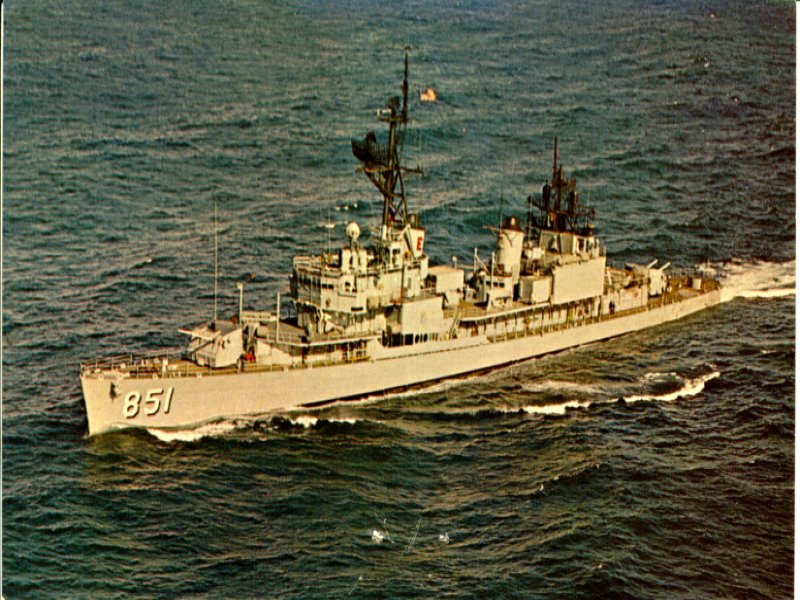
USS Rupertus, Gearing FRAM, a clever recycling of the class to face the Soviet submarine threat in the cold war.
After the war, the Gearings stays as the backbone of the US Navy, until the 1970s. After the DDR conversion, which did well in Korea, they were reconverted and modernized under the ambitious FRAM program, many still kept in reserve in 1980. 3/4 were also sold in the later 1960s and early 1970s to many allied countries and some are still in use today. A beautiful longevity for an emergency design.

USS Ernest G Small after losing her bow to a mine and subsequent heavy seas off Korea 1951. She made it back to Japan for repairs by steaming backwards.
Following World War II most of the class had their AA and anti-submarine warfare (ASW) armament upgraded: The 40 mm and 20 mm guns were replaced by two to six twin 3-inch (76 mm)/50 in two twin and sometimes two single mountings. One depth charge rack was removed as obsolete, instead, two Hedgehog ASW were added. The K-guns were retained. The extra DDRs for the early 1950s had one twin 3-inch mount only.
DDE
There were also conversions as escort destroyers (DDE), this time with an extra ASW armament. USS Carpenter became the prototype for such conversion. She was completed with two twin 3-inch/70 guns in enclosed mounts, two Weapon Alpha launchers, four new 21-in torpedo tubes, firing the Mark 37 ASW torpedo, and single depth charge rack (DCR).
FRAM I upgrade
In the late 1950s-early 1960s, seventy-nine Gearing-class destroyers were taken in hands for extensive modernization under the FRAM I program or project SCB 206. The Gearing were originally designed as anti-aircraft destroyer to screen and protect fast carrier formation. Now this task was devoted to new guided missile destroyers, and so they were repurposed as an anti-submarine warfare ships. All previous DDR/DDE equipment was removed for those previously converted and they fell back to their former DDs numbers. In the end, all but three Gearings received FRAM conversions, either I or II.
FRAM I “A” Ships (8 convered) lacked their aft twin 5-inch mount, two MK10/11 Hedgehogs close to the bridge, MK-32 triple torpedo launchers close to second funnel.
FRAM I “B” Ships (remainder): “B” mount removed, “C” mount kept. Practice 5-inch reloading machine installed, MK-32 TTs aft of the loader, greater ASROC/torpedo storage and DASH hangar.
The FRAM I program Consisted in rebuilding the superstructures (with notably a new recoignisable enclosed and well glassed bridge), brand new electronics, new SPS-10 surface search radar, new SQS-23 sonar sonar, and new weapons. The “B” 5-inch gun mount was removed as all AA and ASW equipments. One variant had the two forward 5-in mounts kept, the “C” removed. As for the new weapons, they carried two triple Mark 32 torpedo tubes with acoustic torpedoes, and a 8-cell ASROC box launcher generally placed amidships (with the TT they shared the same Mk. 44 homing but the ASROC also allegedly had a small number of nuclear depth charges), plus a small hangar and helideck for a single QH-50C DASH ASW drone helicopter. On 11 May 1962 USS Agerholm was the first to live test an ASROC launched nuclear tipped torpedo, in the “Swordfish” test, proving the concept. How much nuclear charges were carried by these ships remains classified to this day. But because of this, the FRAM could not enter ports that banned these armaments.
The “FRAM cans”, are a large part of the cold war ASW armada deployed against more numerous and competent Soviet Submarines, an extended menagerie of SSBN, SSNs, SSKs, SSGs and SSGNs.
The Gyrodyne QH-50C DASH was quite ambitious given the technologies of the time. This was the first drone. An unmanned anti-submarine helicopter remotelly controlled. On paper it carry two Mark 44 homing ASW torpedoes and was lighter and smaller than a standard helicopter, so a very tempting solution for limited space aboard. It was notably to compensate for the ASROC initial 5 nautical miles (9.3 km; 5.8 mi) range. The DASH extended on paper this bubble to 22 nmi (41 km; 25 mi) away. But this tech proved immature and the DASH was lauded as completely unreliable: 50% of the 746 drones were lost at sea, between potentially inadequate maintenance support, unsufficient training, and just limited tech. Remote systems were used since WW2. The USMC notably tested a large aircraft drone filled with explosive already in 1944. But drone ASW helicopter will only mature in the 2020s…
By 1970, DASH had been withdrawn from all FRAM I ships but not from FRAM II ships, which had no ASROC. The LAMPS program replaced DASH but never were adopted on the Gearing class, too small for these. This explains why they were sold by droves.
FRAM II upgrade
The FRAM II program was designed for the Allen M. Sumner initially, but sixteen Gearings underwent it due to commonality. This life-extension refurbishment saw the adoption of a new radar, Mark 32 torpedo tubes, same DASH drone, but more importantly a new variable depth sonar (VDS) aft and no ASROC. Six DDRs and six DDEs converted that way also kept some of their initial specialized equipment.
FRAM II ships kept all their main guns except DDEs which had a trainable Hedgehog in No. 2 position. They all had two Hedgehogs or a trainable Hedgehog mount instead of ASROC. Four DDRs kept their two new 21-inch TTs for Mk. 37 ASW homing torpedoes, no DASH facilities. They were seen very much as an “austere” variant of FRAM-I as budget restrain measure.
Gearings FRAM in Vietnam
Gearings provided gunfire support in Vietnam War in addition to their ASW patrol roles, they escorted Carrier Battle Groups and Amphibious Ready Groups, but lost many of their DASH before they were withdrawn in 1969. FRAM II ships left service in 1969–1974 and were not sold that often. This with ASROC (FRAM I) solidiered on until the fall of Saigon in 1975, provide a standoff ASW capability and ended either decommissioned or transferred aboard in 1973–1980. Their true successors were the immensely larger Spruance-class destroyers, commissioned 1975–1983. Their main advantage was to carry a Kaman SH-2 Seasprite, and from 1984, Sikorsky SH-60 Seahawk, brining invaluable addon capabilities compared to the mediocre DASH. A few Gearings still around in the Naval Reserve Force (NRF) from 1973 onwads remained in semi-commission with partial crews for training Naval reservists well into the 1980s. USS William C. Lawe was the last of these WW2 vets, decommissioned, stricken on 1 October 1983, sunk as target 14 July 1999. None was preserved as a museum ship.
Many of those sold aboard however continued to serve for decades; The most impressive case remained the ROCS (Taiwan navy) ships, modernized locally and… still in service in the late 2000s.
 Yang class 1970
Yang class 1970
After the Gearing-class ships were retired from USN service, many were sold abroad, including over a dozen to the Republic of China Navy (ROCN) in Taiwan. These ships, along with Fletcher-class destroyers and Allen M. Sumner-class destroyers also acquired then, were upgraded under the Wu Chin (Chinese: 武進) I, II, and III programs and known throughout the ROCN as the Yang-class (Chinese: 陽字號) destroyers as they were assigned names that all end with the word “Yang”. The last batch of 7 WC-III program vessels, all of them Gearing class, were retired in the early 2000s.[17]
Under the most advanced Wu Chin III upgrade program, all World War II vintage weapons were removed and replaced with four Hsiung Feng II surface-to-surface missiles, ten SM-1 (box launchers), one 8-cell ASROC, one 76 mm (3 in) Otobreda gun, two Bofors 40 mm AA, one 20 mm Phalanx CIWS and two triple 12.75 in (324 mm) torpedo tubes. The DASH ASW drones were not acquired, but hangar facilities aboard those ships that had them were later used to accommodate of MD 500/ASW helicopters.
After the Yang-class destroyers were decommissioned, the SM-1 launch boxes were moved to Chi Yang-class frigates to improve their anti-air capability.
 Churruca class 1972
Churruca class 1972
Churruca was the ex-Eugene A. Greene transferred in 1972, but also Gravina, Méndez Núñez, Lángara and Blas de Lezo.
 Gangwon-class 1972
Gangwon-class 1972
ROKS GangWon, Chungbuk, Taejon, Gwangju, Gyeonggi, Jeonju.
https://en.wikipedia.org/wiki/Gangwon-class_destroyer
 (Unnamed) Spares only.
(Unnamed) Spares only.
Both USS Kenneth D. Bailey and USS Bordelon were transferred on 13 January 1975 to Iran but never renamed nor receiving official numeral. They were only used for spare parts and BU.
 Themistoklis class (1971)
Themistoklis class (1971)
The ex-USS Frank Knox DD-742 as Themistoklis, USS Gurke (as Tombazis (D215)), USS Corry as Kriezis, USS Charles P. Cecil as Apostolis (D216), USS Arnold J. Isbell as Sachtouris, USS Stickell as HS Kanaris, and there was also USS Rupertus, on loan as Kountouriotis and then purchased. USS Myles C. Fox and USS Dyess were also purchased for spares (unammed, BU).
Read More
Books
J.Gardiner Conway’s all the world’s fighting ships 1922-47 and 1947-95.
Links
on destroyerhistory.org/
maritime.org/doc/plans/dd765.pdf
dd710.com/GJ/GJGearingFamily.pdf
navysite.de/dd/dd710.htm
navypedia.org/ships/usa/us_dd_gearing.htm
history.navy.mil/
www dd710.com/
globalsecurity.org
on navsource.org/
on militaryfactory.com
on uboat.net
on armedconflicts.com/
en.wikipedia.org/ category images CC
en.wikipedia.org/
Model Kits
Let’s cite here the old but large Tehnoart Models 1:192 or the more reasonable Blue Water Navy 1:350. Dragon made one at the same scale. There is no shortage of 1:700 models too, both WW2 and post-FRAM conversion.
General query on scalemates
Videos
The Gearing class destroyers in service
Class: USS Gearing, Eugene A. Greene, Gyatt, Kenneth D. Bailey, William R. Rush, William M. Wood, Wiltsie, Theodore E. Chandler, Hamner, Epperson, Frank Knox, Southerland, William C. Lawe, Lloyd Thomas , Keppler, Rowan, Gurke, McKean, Henderson, Richard B. Anderson, James E. Kyes, Hollister, Eversole, Shelton, Seaman, Chevalier, Higbee, Benner, Dennis J. Buckley, Corry, New, Holder, Rich, Johnston, Robert H. McCard, Samuel B. Roberts, Basilone, Carpenter, Agerholm, Robert A. Owens, Timmerman, Myles C. Fox, Everett F. Larson, Goodrich, Hanson, Herbert J. Thomas, Turner, Charles P. Cecil, George K. Mackenzie, Sarsfield, Ernest G. Small, Power, Glennon, Noa, Fiske, Warrington, Perry, Baussell, Ozbourn, Robert L. Wilson, Witek, Richard E. Kraus, Joseph P. Kennedy, Jr., Rupertus, Leonard F. Mason, Charles H. Roan, Fred T. Berry, Norris, McCaffery, Harwood, Vogelgesang, Steinaker, Harold J. Ellison, Charles R. Ware, Cone, Richmond, Stribling, Brownson, Arnold J. Isbell, Fechteler, Damato, Forrest Royal, Hawkins, Duncan, Henry W. Tucker, Rogers, Perkins, Vesole, Leary, Dyess, Bordelon, Furse, Newman K. Perry, Floyd B. Parks, John R. Craig, Orleck, Brinkley Bass, Stickell, O`Hare, Meredith (+10 cancelled)
 USS Gearing (DD 710)
USS Gearing (DD 710)
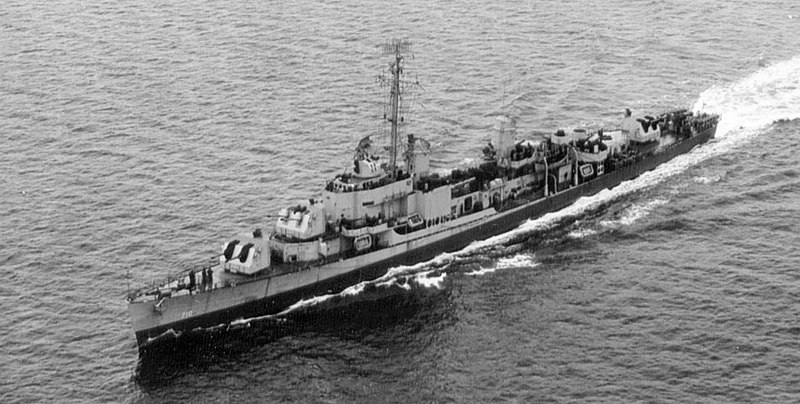
USS Gearing 25 April 1945 on sea trials. She will continue on with her shakedown cruise in May-June.
After a shakedown cruise off Cuba, she was sent to Norfolk on 22 July 1945 for initial training with crews for other destroyers and moved to Casco Bay, Maine on 5 October, while the war has ended, so she had no chance to se action. She moved to Pensacola, Florida on 4 November to cover the newly commissioned USS Ranger (ii) during her own qualification operations.
Back to Norfolk 21 March 1946, she went on the Atlantic coast, North and South America and south to the Caribbean, stopping in Montevideo, and Rio de Janeiro. On 10 November 1947 she made her first Mediterranean cruise, stopping in Algeria, Malta, Italy, and France and back to Norfolk on 11 March 1948.
She went on in service on the eastern seaboard and Caribbean and started a second cruise in Europe through the Mediterranean (10 November 1947 – 11 March 1948) and did the same between 4 January to 23 May 1949, concluded the year with Operation Frostbite in the Arctic. After operations on the east coast and Caribbean in 1950, she made another trip on 10 January-17 May 1951 in the Mediterranean and ended with training cruises to Halifax and Cuba.
Until 1960 she went on with the same yearly routing, between the Mediterranea and exercizes between North Atlantic and the Caribbean. She took part in negotiations during the Santa Maria hijacking, and entered the drydock for a first serious modernization and overhaul, from late 1961 to early 1962 in Boston. She also took part in the Cuban missile crisis. From there, the rest, including her FRAM I conversion will be the object of a separate article.
 USS Eugene A. Greene (DD 711)
USS Eugene A. Greene (DD 711)
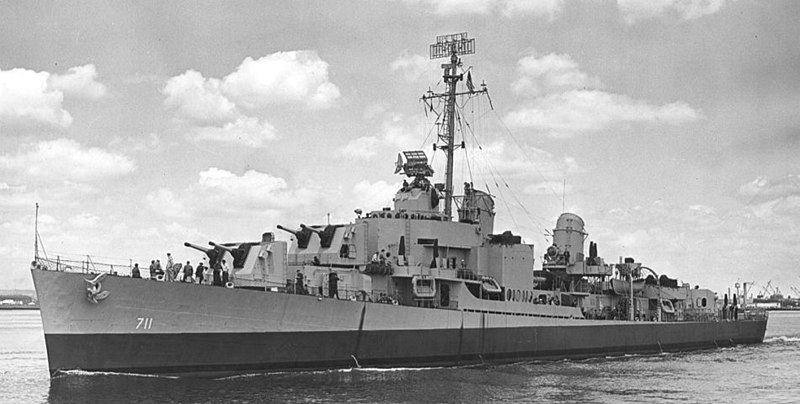
USS Eugene A Greene (DD 711) in 1945, just commissioned. Later after a career as radar picket she will revert as destroyer untol 1972 and served with the Spanish Navy until 1991, seeing the last days of WW2 and of the cold war.
Eugene A. Greene was commissioned on 8 June 1945, leaving little time to train and work out before the war ended on 15 August. She made her sea trials, initial training and shakedown cruise along the east coast and Caribbean. She later acted as “plane guard”, rescuing pilots during pilot qualification of recently Essex-class carriers, also training crews for new destroyers. She was, like USS Gearing, based in home port Norfolk in Virginia, east coast.
She went to Guantanamo Bay in 1947, and by February took part in a task group off Montevideo, continued with festivities for the inauguration of Uruguay’s President Berres, with behind a good will visit to Rio de Janeiro and back to Norfolk.
On 10 November 1947 USS Eugene A. Greene inaugurated the first of nine Mediterranean cruises, for thirteen years. She also toured northern Europe and the Arctic in between routine fleet exercises, without noticeable event. She was decommission on 1 April 1952, for a conversion until 1 December 1952, as a dedicated radar picket, redesignated DDR-711, fully recommissioned on 18 July 1952.
The rest will be the object of a dedicated FRAM article.
 USS Gyatt (DD 712)
USS Gyatt (DD 712)
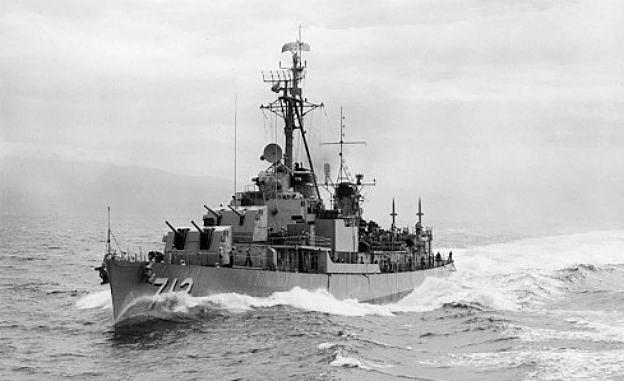
USS Gyatt was commissioned on 2 July 1945. After shakedown in the Caribbean she reported to Norfolk and started her peacetime schedule along the East Coast. In addition to operations and training she escorted new or refitted aircraft carriers in the Gulf of Mexico and Caribbean for their own shakedown cruise. She left Norfolk on 24 January 1947 for Uruguay, as ambassador of the US for the President Berres electrion ceremonies at Montevideo (27 February 1947 to 6 March 1947), and later visited Rio de Janeiro and Port of Spain in Trinidad.
On 20 November 1947 she joined the 6th Fleet in the Mediterranean and back to HP Norfolk on 2 March 1948, making six more deployments there and to Northern Europe, with another northern trip once to Nova Scotia and Iceland.
USS Gyatt entered the Boston Naval Shipyard on 26 September 1955 for conversion. When recommissioned she became the world’s first guided missile destroyer, having a twin Terrier guided missile launcher installed, the Denny-Brown stabilization system (two 45 sq/ft or 4 meters square) retractable fins midships, below the waterline to further reduce pitch and roll. Now reclassed as DDG-712 on 1 December 1956 she was recommissioned on the 3rd.
After three years of intensive evaluation as a prototype conversion, she trained on the Atlantic coast and became DDG-1 as recoignition for her pioneering role by 23 May 1957, joining the 6th Fleet on 28 January 1960, first of her type overseas. She was homeported to Charleston, taking part on east coast fleet exercizes-training and back to the Mediterranean.
She also took part in the space program, for nose-cone recovery station 5–10 November 1960 and 24–26 April 1961 (Project Mercury). She was back in Europe for the Berlin crisis by the winter of 1961 and until 3 March 1962, then back to the eastern seaboard.
She had another overhaul at Charleston on 29 June 1962, (missile removed, new equipment by the Operational Test and Evaluation Force) and was reclassified DD-712 on 1 October 1962. Rzady by 1 January 1963 she went on testing systems off until 1964-67. She trained in ASW with officers and guided missile destroyer tactics. Transferred to the Select Reserve she was homeported last at Washington, D.C. by 1968, but stricken on 22 October 1969 and expended as target off Virginia, 11 June 1970.
 USS Kenneth D. Bailey (DD 713)
USS Kenneth D. Bailey (DD 713)

Bailey was commissioned on 31 July 1945. She was in early training when the war ended, never venturing in the Pacific. After Caribbean shakedown she started service in the Atlantic, New England and Caribbean, HP Newport (Rhode Island) and later Norfolk (Virginia), used as plane guard during new carriers pilots qualification and training new destroyers crews. From 13 February to 26 March 1947 she sailed to the South American east coast. 10 November 1947 was the start of her first Mediterranean deployment, until 5 January 1948, patrolling of Greece (civil war). She made another deployment from 13 January to 12 May 1949 watching over Israel and maintaining peace between Italy and Yugoslavia (Trieste crisis). Next was a 3 September 1951 – 4 February 1952 deployment from Spain to Turkey. In beteween the salso ventured to the Arctic Ocean and Northern/Western Europe for joint exercizes and training naval reservists when in home waters, or acting as plane guard. On 2 December 1952 she was overhauled and refitted at Boston Naval Shipyard to be radar picket destroyer, DDR-713, acting as such from 1953 to 1967.
From Newport, she trained along the East Coast before joining the 6th Fleet by May 1954 and NATO in the Eastern Mediterranean. She made another deployment from 5 November 1955 to 17 March 1956 and patrolled the Red Sea (Suez crisis). In April 1957 she supported King Hussein’s government. On 2 September 1958 to 28 March 1959 she patrolled off Lebanon.
HP to Mayport on 16 June 1959 she entered Charleston on 26 January 1960 for her FRAM II overhaul over 9 months. On 14 November she sailed to Guatemala-Nicaragua (Cuban blockade before the missile crisis). On 9 February 1961 she made another 6th fleet deployment over six months and made five others until 26 October 1966. Next year she was in Charleston for her last overhaul.
She was decommissioned on 20 January 1970, stricken 1 February 1974, sold to Iran 13 January 1975 for spares.
 USS Frank Knox (DD 742)
USS Frank Knox (DD 742)
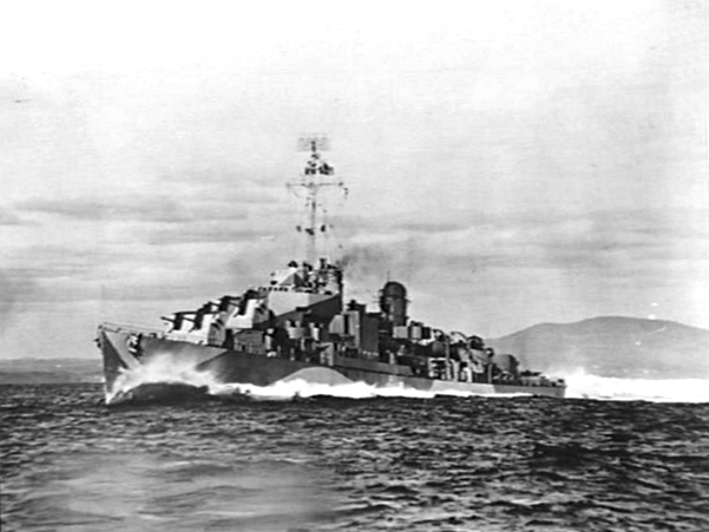
USS Frank Knox was from Bath, Maine, Commissioned in December 1944, and ready in time to gain the western Pacific by mid-June 1945, taking her place for the home island last days carrier air raids with TF 38. She took part in the Battle of Okinawa as radar picket and ended in Tokyo Bay on 2 September 1945, remaining there until early February 1946. She would return to the region several times until 1949, modified and reclassified as radar picket DDR-742 by March 1949.
She saw the start of the Korean war in July 1950, stayed on duty until 1951, seeing the Battle of Inchon and shelling shore targets as well as patrolling the Taiwan Straits. She made two more Korean war deployments in 1952 and 1953 and kept her WestPac, 7th Fleet assignments until 1959.
Back home in 1960–1961 she was modernized under FRAM II, with updated radars and new bridge. From 1961 to mid-1964 she returned to the Pacific for more deployments, including a tour of Australia. By June 1965, she made a brief Vietnam tour of duty, for naval gunfire support, coastal patrol. After transitioning from Tsoying Naval Base in Taiwan while to the South China Sea she ran aground on 18 July on Pratas Reef. Salvage was difficult, and was repaired at Yokosuka in 1966.
She was back in action by November 1966, detached for Vietnam combat several times and redesignated DD-742 by 1969, making her final tour by November 1970, decommissioned when back home in January 1971. However she was transferred to the Greek Navy as Themistoklis (D210), making two more decades until decommissioned in the early 1990s, expended as torpedo target by the submarine Nireus (S-111) on 12 September 2001…
 USS Southerland (DD 743)
USS Southerland (DD 743)

The destroyer was commissioned on 22 December 1944 and after a short shakedown in Bermuda by February 1945 and exercises up to April departed on the 24th to join TU 23.16.1 bound for the Pacific. She was in Pearl Harbor on 15 May, then Ulithi on 28 May and by June, Leyte and TF 38, for the final home island raids. From 10 July she screened the carriers striking Honshū and Hokkaidō, and was detached for night shore bombardment, at Hamamatsu in southern Honshū (29-30 July) and Kamaishi on northern Honshū (9-10 August).
She planned striked on Tokyo by 15 August but that was V-Day. On 27 August she entered Sagami Wan, then Tokyo, first to enter the harbor. On the 30th she saw the first occupation troops landings at Huttu Saki, Yokosuka and joined TG 35.1. She allegedly was the first to enter Tokyo Bay and by January 1946, departed back home. For her WW2 service she won a single battle star.
She was back in the Central Pacific by November 1946 and returned by February 1947, visiting Shanghai, cruised along the China coast (Chinese civil war) and was back in Japan in June before heading for home. This routined repeated in 1948 and 1949, and she acted as radar picket, DDR-743 by 18 March 1949. In June 1950 she was in Hawaii when hearing about the war in Korea. She sailed in July to Okinawa before starting missions along the Korean coast.
By September, she joined TF 90 and took part in the Battle of Inchon with Fire Support Group 3 on 15 September. On 16 September she took a hit from counterbattery fire and departed on the 17th. She stayed with TF 77 patrolling from Pusan to Wonsan-Ch’ongjin. January 1951 saw her back in the Taiwan Strait and rest in Japan, then home.
On 10 February 1952 she was back to Korea, assigned to TF 95 (UN Blockade, west coast). After training off Okinawa she was back in April after the Panmunjom armistice and screened TF 77, detached for shore bombardments, notably Ch’ongjin.
On 18 April, she was back in Japan, then back in Korea on 11 May, TF 77, operating at Ch’ongjin and Wonsan. She also returned to the Taiwan Strait and assigned to TF 95. On the 14th she silenced seven shore batteries traded for four direct hits (8 casualties), repaired in Sasebo and back to San Diego.
Mid-April 1953 saw her departure for another Korean TOD. May-June, and after a stop in Japan, the truce line, departing for home on 2 October. For her Korea was service she won 8 battle stars.
After Korea she went on with the 7th Fleet, WestPac, but was detached for 1st Fleet operations, making several Far East deployments, SEATO exercises, Taiwan Strait patrols. By December 1958, she assisted USS Princeton in emergency relief after the floods in Ceylon.
By 1962 she was with TF 8 for Operation “Dominic” (Christmas Island atomtic test).
Back home she was converted to FRAM I in 1963–1964. She was ordered to Vietnam soon after October 1964, back as DD-743 in April. She joined TF 77 in the South China Sea, plane guard, then “Operation Market Time” (trawler surveillance duty) and gunfire on the I Corps area. She was back to San Diego and returned 9 months later. She started operation on 8 July 1966 with USS Intrepid near the Mekong Delta, detached on 19 July for fire support. She also operated on the Tonkin Gulf with USS Franklin D. Roosevelt. Back home she became ASW School Ship and, Engineering School Ship, had a new overhaul and departed on 28 December for Vietnam.
Her next tour was until 28 June 1968, then another from 18 March to 3 July 1969. She was back home at San Diego on December. In 1971, she served with Composite Unit Training Exercises off southern California and returned in the summer for the western Pacific until 5 December, notably with USS Enterprise. For her Vietnam service she won 10 battle stars.
By June 1972, she entered Long Beach Naval for a last overhaul until 9 November with her main propulsion plant converted to use navy distillate fuel.
Operations (local) went on until mid-June 1973. She trained reservists from Seattle, Washington, took part in Operation “Charger SurfPac 1-73” and stayed off San Diego to Pearl Harbor for joint exercises with the RN in 1974. Until late 1980 she kept her training ship routine for reservists but had a reduced crew. In the fall of 1980 she took part in the last naval gunnery exercises off of southern San Clemente Island, and was decommissioned on 26 February 1981. Stricken on 26 February 1981 she was planned for tansfer to the Ecuadoran Navy but ended as target on 2 August 1997.
 USS Rowan (DD 782)
USS Rowan (DD 782)

USS Rowan was laid down on 25 March 1944 at Todd Pacific Shipyards in Seattle, Washington, commissioned on 31 March 1945 and after shakedown off southern California and workout at Puget Sound she departed Seattle for Hawaii and then Okinawa but arrived after Japan’s surrender. She remained with occupation forced until December and returned home via Okinawa by January 1946.
In San Diego on 10 February she was semi-mothballed until February 1947 and resumed operations along the west coast, making another deployment in the western Pacific and back to San Diego on 30 April 1948, then local operations in 1949 and another WestPac in March-November.
On 25 June 1950 she ws mobilized for the Korean War, departing Sasebo on 12 September for a support mission at Inchon with TF 90, providing gunfire to the 5th Marines ashore and remaining in the area until 3 October for patrolling off the Korean east coast. In October 1950 sge took part in the Wonsan attack force. On the 26th she supported the 1st Marines on the Kalma Peninsula and remained in November for on-call gunfire support, guard duty and sailed for home by February 1951.
Local operations until January 1952 saw her prepared to return to Korea, 15 February in the Wonsan area, she also patrolled along Northern Korea, and duelled with a North Korean shore battery, having a direct hit disabling her 40 mm gun, radar and superstructure.
On 22 February 1952 she took another hit from a shore battery at Hungnam. She took part in the Siege of Wonsan, On 18 June 1953 and againt was hit by Shore Batteries, some 45 rounds, five hit, being holed and loosing her Mark 34 Radar with 9 crewmen injured. By late June she was retired to the Taiwan Patrol Force and after another go in Korea was sent to San Diego.
She made her 3rd Korean TOD by mid-April 1953 alternated with the Taiwan patrol in July. Her last deployment was in August-September and by October left Yokosuka for home.
After Korea she returned to the 7th Fleet and 1st Fleet between Hawaii and WestPac. She was detached to recover a Nuclear Emulsion Recovery Vehicle (NERV) capsule in September 1960 and Operation Dominic (Kiritimati tests in 1962).
On 3 June 1963 she underwent her FRAM I conversion at Philadelphia. Next she was deployed several times off Vietnam. She provided gunfire support to the Vietnamese Navy Junk Force, Qui Nhon area and “Market Time” patrol. After being back to San Diego she was back by May 1966 to support the IV Corps, alternated with plane guard duty and back home, local operations with the west coast’s 1st Fleet.
In November she was used as ASW Schoolship at San Diego and in December made tests off California followed by an overhaul and back with the 7th Fleet in the IV and II Corps areas/plane guard in the Tonkin Gulf. By April 1968 after exercises in the Sea of Japan she took part in Operation Formation Star, returned home, then back in Vietnam later in 1970 after an overhaul starting in January at Hunter’s Point Naval Shipyard until 15 June. She was back home on 12 March 1971 and returned to Vietnam on 20 October 1971 for an extended deployment until mid-1973.
On 27 August 1972 she escorted USS Newport News, USS Providence and USS Robison during a night raid into Haiphong, closing to 2 miles (3.2 km) to shell the harbour until engaged by torpedo boats 27 miles (43 km) southeast of Haiphong. USS Newport News sank one, the other was taken care of by USS Rowan, finish off by an A-7 jet. Next she took part in “Operation Frequent Wind”, 29-30 April 1975, evacuating nationals until the fall of Saigon.
USS Rowan was decommissioned back home, at San Diego on 18 December 1975, stricken on 30 January 1976, transferred to the Republic of China on 1 June 1977 as ROCS Chao Yang (DD-16) for many more years of service. She won 4 battle stars for Korea, 11 for Vietnam.
 USS Gurke (DD 783)
USS Gurke (DD 783)
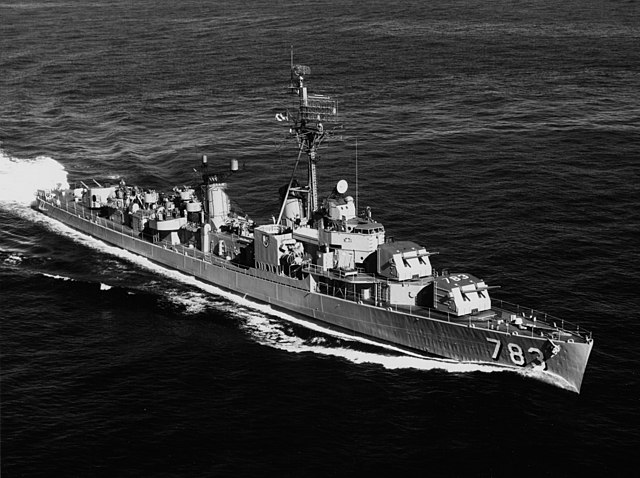
USS Gurke was commissioned on 12 May 1945 and after shakedown, sailed for the Western Pacific on 27 August 1945, Pearl Harbor and taking her part in the occupation of Japan until back to San Diego, by February 1946, and training until 4 September 1947 before anither WestPac deployment, and two more alternating between 1st fleet local ops from San Diego, a sweep to Alaska in 1948 (50th anniversary of the Yukon gold rush). On 5 August 1950 she arrived in Yokosuka for training before the Korea war assignment. On 19 August she joined the fast carrier task forces from 25 August to 6 September. She shared awards to TE 90.62 for “extraordinary heroism” at Inchon on 13–15 September 1950. She shelled Wolmi-do island and the Inchon waterfront, appearing as a “sitting duck” and taking three hits. She delivered a punishing rolling fire on 15 September 1950 before the Marines arrived at Wolmi Do on high noon. Her actions were later commanded by Douglas MacArthur.
After Inchon she returned screening the carriers launching strikes inland on the retreating North Koreans. She also patrolled the Formosa Straits to prevent a PLA invasion of Formosa and served as flagship, Vice Admiral Arthur D. Struble, TF 77 CiC.
She went back home and returned in Korea with the 7th Fleet for various missions, including duelling and taking hits from Communist shore batteries, notably on 25 June 1953.
After the ceasefire of August 1953, she patrolled the Far East alternated with home exercizes. On 17–18 June 1960 she escorted the cruiser USS Saint Paul (CA-73) with President Dwight D. Eisenhower aboard for a Manila—Taiwan cruise.
In June 1962 she took part in Operation Dominic I off Christmas Island.
She had her FRAM I overhaul at Puget Sound from July 1963 until 15 May 1964 and on 21 October returned to the Far East, Yokosuka and 7th Fleet operations by November 1964 as plane guard for Task Force 77., then assigned to TG 77.7, South China Sea, for USS Ranger (CVA-61) and USS Hancock (CVA-19). She stayed as escort during the early phase of the Vietnam War by January taking part in the assault of Da Nang. She patrolled to Subic Bay and Hong Kong. On 20 April 1965 she escorted Ranger back to San Diego on 7 May 1965. She trained there up to Seattle, and returned to Hawaii, Japan, and the Philippines, taking her place in the Gulf of Tonkin for SAR missions. On 1 July she detected three NVA PT boats 11 miles (20 km) away, dealt with by planes of USS Constellation (CV-64).
She refueled helicopters by a new in-flight refueling process as well. After rest she was back in the Gulf of Tonkin by September, completing 113 in-flight refuelings and sheling Viet Cong positions (Mekong-Saigon River delta) and was back home on 16 November. In 1967 she trained along the West Coast. By November she returned to Japan, arrived at Yankee Station for SAR and Operation Formation Star. She sailed south for the 1968 Tet Offensive, for Naval Gunfire Support at Hue. After rest at Hong Kong she retuned for Operation Sea Dragon, North Vietnam and back to to San Diego in June 1968. In April 1975 she returned to Saigon to cover Operation Frequent Wind.
She was decommissioned, stricken on 30 January 1976, transferred to Greece on 17 March 1977 as Tombazis (D 215), staying active until 1994. She earned 7 battle stars for Korea, unknown for Vietnam.
 USS Mc Kean (DD 784)
USS Mc Kean (DD 784)
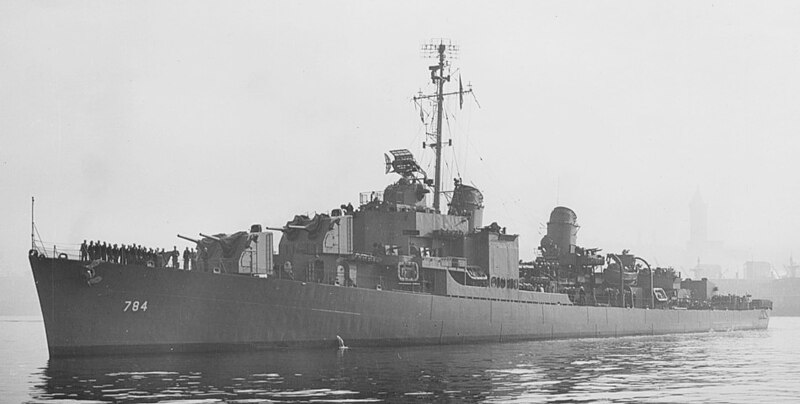
USS McKean freshly completed. Note the dark ocean blue livery.
USS McKean was commissioned on 9 June 1945, and arrived too late in Japan for active operations, and instead spent the autumn of 1945 to patrol and cover occupation forces. Her missions included clearing Allied floating mines from Japanese waters. She was back home for local operations training in 1946-49. Then when the war broke out in Korea June 1950, she had an overhaul at Long Beach, and joined the 7th Fleet in August, escorting TF 77 as part of DesDiv 112.
She took part in the Inchon landings. She was detached into Chinnampo River, discoering a first naval minefield, but also dropped five depth charges on a submarine contact on 23 September 1950. She then joined TF 72 in the Taiwan Strait, escorting USS Manchester, with her sisters USS Frank Knox, Hollister, Ozbourn and weathering Typhoon Clara.
November 1950, saw her bringing support during the battle of Chosin Reservoir on 27 November. She patrolled the Formosa Strait and moved to Chinhung-ni and Hŭngnam to evacuate US troops until 24 December (105,000 troops, 91,000 refugees) before being overhauled at Yokosuka and Sasebo. She was back with TF 77 by late December 1950, at the time the largest assembled fleet since WW2, with the battleship USS Missouri (BB-63), aircraft carriers USS Philippine Sea, Princeton, Valley Forge, Badoeng Strait, Sicily, heavy cruiser USS Saint Paul, light cruiser USS Manchester plus 12 destroyers (two desDivs).
There was at the time a strong concern that the Soviet Navy would try to help the North Koreans and TF 77 escorts had strict orders to depth-charge any suspected submarine. On 18 December 1950, USS McKean (codename “Rancher”) en route from Sasebo with USS Frank Knox “Rancher” was steaming with USS Frank Knox, obtaining a hard contact from sonar. Soon were ordered depth charge runs. It seemed evasive action were taken by the subs but the captain ordered another depth charge run, fed with accurate data delivered by a tracker aircraft unil spotting air bubbles and an oil slick later spotted by USS McKean and Frank Knox. They lost contact, regained it and made another additional run. That day McKean fired 54 depth charges, 84 over 24-hour and on 19 December, one of the airplanes signalled a torpedo wake astern of USS McKean. Officially it seems that has been two Russian submarines there. And a probable sinking alhtough decoys were released.
By January 1951 USS McKean was back with IF 95 for shore bombardment, blockade off Wonsan, Songjin, Chinjŏn. In 1952 she was converted as radar picket, DDR-784. She was used also for the film “The Caine Mutiny” and by 1955 took part in the A-Bomb test Operation Wigwam. In 1956 she visited Melbourne (Olympic Games).
Missing logs form 1957-1964.
In February 1964 she was overhauled as FRAM I at Long Beach and by July 1965 back to the 7th Fleet, 4 months of operations with USS Oriskany (CVA-34), South China Sea Attack Carrier Strike Group. During her deployment she fired 1,000 rounds on shore targets.
Back home she took part in “Eager Angler” and Baseline II.” Back in Vietnam she won the “Best Gunnery Ship” award. In November 1966 she was deployed for SAR in the Gulf of Tonkin and setup a record of 100 inflight helicopter refuelings on 30-day. She made also gun line deployments (4,000 rounds) and having some R&R in Australia and New Zealand for Battle of the Coral Sea ceremonies. Next in 1967 she was overhauled at Mare Island.
In March 1968 she returned to Vietnam via Pearl Harbor, Yokosuka and Sasebo, taking part in Operation Formation Star, and took part in the pressure fleet sent to North Korea for the release of the Pueblo’s crew (AGER-2) from 23 January 1968. She returned in the Tonkin Gulf and visited later Hong Kong and Kaohsiung then back to HP Long Beach and WestPac in 1970, visiting Bangkok, Guam, Hong Kong, the Philippines and the gunline off Vietnam. November 1971 saw her in escort of HMS Eagle to the Indian Ocean before joining the 7th Fleet. December 1971 saw her with TF 74 during the Indo-Pakistani War. She also visited New Guinea and was back home in November 1971.
May 1972 saw her training reservists with the reserve naval forces and latter based in Seattle. In 1976, she was used in the movie “Midway.” She was stricken on 30 September 1980, decommissioned in October 1981 and sent to Turkey as spare parts reserve, spent as target by Harpoon in July 1987.
 USS Anderson (DD 785)
USS Anderson (DD 785)
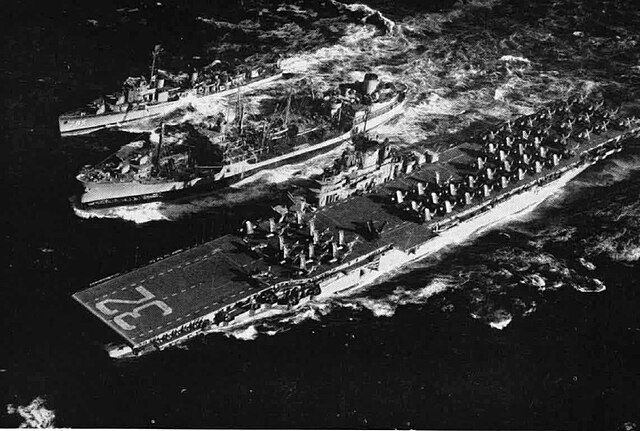
Henderson and the aircraft carrier USS Leyte (CV-32) being refueled off Korea between October 1950 and January 1951.
USS Henderson was from Todd Pacific Shipyards in Seattle, commissioned on 4 August 1945. After her shakedown cruise out of San Diego, then departed Seattle on 31 October for Hawaii. Upon her arrival on 7 November she became screen ship for escort carriers and doing experimental sonar tests at NS San Diego by 23 April 1946. On 2 December she took part in the antarctic expeditions, “Operation Highjump” and ended in Sydney on 13 March 1947, back home by 6 April.
She made two mre WestPac deplyments, including one with occupation forces in Japan. By August 1950 her Korean campaign began. From Yokosuka she became screen ship for the new fast carrier force and later joined the Inchon invasion assault force, entering the flying Fish Channel on 13 September and shelling the waterfront, duelling with shore batteries and remaining for fire support duty until 1 October.
Next she patrolled the coast of Korea and Formosa Strait, stopped at Keelung on 20 March before setting for home. By January 1952 she was back in Korea, Hŭngnam for the blockade and norther coast patrol, plus occasional gunfire support until 7 March. She screened USS Bataan (CVL-29) off Japan and operated with the fast carrier task force and Formosa Strait until back on 10 August 1952.
After training off San Diego until 22 March 1953 she started a third Korean tour, siege of Wonsan, troop support gunfire, ASW patrols off Okinawa. This went on until the armistice of July 1953, spending 22 months continuous at sea.
Next she went on for more cruises in the Far East for a decade. She shielded the Quemoy Islands by September 1954, relieved Ceylonese flood victims (January 1958) took refuge in Hong Kong from typhoon Mary and back home in the early 1960s she underwent the FRAM I refit at Mare Island until April 1962. She resumed operations from 11 August 1964, with annual cruises to Vietnam for the 7th Fleet, with bombardments missiones and plane guard duties at “Yankee Station”. She was back at Long Beach on 16 December and back in Vietnam by 10 July 1965. She served in the South China Sea and Gulf of Tonkin with USS Oriskany (CV-34), detached to the gun line, notably in the Gulf of Siam, Ca Mau Peninsula. She escorted also USS Bon Homme Richard (CVA-31) and sailed back to Long Beach on 13 January 1966.
She became an ASW school ship in 1966, and by July searched for the missing plane of Brigadier General Joseph Warren Stilwell, Jr., then was back in Vietnam by January 1967 for four months of screening carriers; bombardment duties. By early 1968 she was back to Vietnam, making also visits to Hong Kong, Subic Bay and Japan and back home on 26 September. She screened USS Bon Homme Richard (CVA-31) off North Korea after the Pueblo (AGER-2) affair and Operation Formation Star. She was overhauled in San Francisco.
She was back in the Far East on 18 November, but was damaged by a storm off Midway and was repaired at Yokosuka. After patrolling Korea she returned for three months off Vietnam and notably “Operation Ringmaster I”, rescuing an helicopter crew off Da Nang belonging to USS Constellation (CVA-64).
In January 1971 she was deployed for a sixth Vietnam deployment, gunline on “Yankee Station”, ASW patrols and an exercise, sinking the target sub USS Sailfish (SS-572). In April she trained in gunfire at Tabones range, Philippines, patrolled the Paracel Islands and Taiwan. She stopped at Manus in Papua New Guinea but also Cairns and Sydney or Auckland and Pago Pago.
After a last overhaul at Long Beach she made her last deployment from July 1972, arriving at Da Nang on 14 December and making several naval gunfire support missions, destroeing an enemy battery on Christmas Eve (Combat Action Ribbon) and rescuing the crew of an SH-3 helicopter. She visited Singapore and Hong Kong and took part in “Operation End Sweep” by April 1973, clearing Haiphong harbor and back home by 26 May.
She was placed in the Naval Reserve Fleet, DesRon 27 by October, and converted at Long Beach to Navy distillate fuel. She spent the next six years in reserve training operations with deployments to the Pacific Northwest yearly practice and decommissioned on 30 September 1980, stricken and transferred to Pakistan on 1 October 1980 as PNS Tughril (167), then Nazim when with the MSA from 1998 at Karachi, decommissioned in 2001. For Korea she received eight battle stars, seven for Vietnam, with a Navy Unit Commendation for Inchon.
 USS Chevalier (DD 805)
USS Chevalier (DD 805)
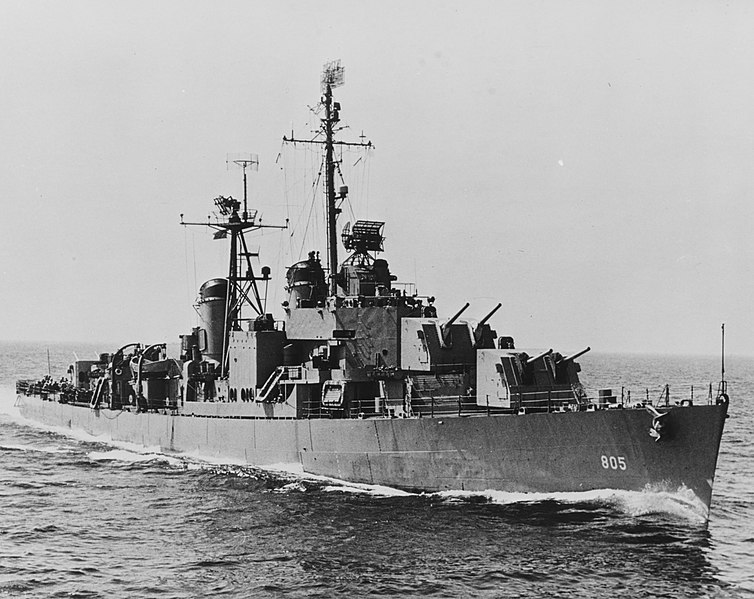
USS Chevalier was built at Bath Iron Works in Maine, commissioned 9 January 1945. She became a radar picket with her mid-section TTs removed and replaced by a second radar mast, aft TT banks replaced by a quad AA bofors. She left her shakedown at Guantanamo Bay on 18 June 1945 for Pearl Harbor on 9 July, joined the bombardment of Wake on 1 August, Eniwetok and TF 38 off Honshū by 18 August, then Tokyo Bay on 26 August. She supported occupation duties and travelled to the Marianas and Philippines, then Saipan and headed for home on 25 March 1946. For her short WW2 service she won a single battle star.
She made several WestPac tours of duty by 1946–7, 1948–9, and on March 1949 reclassified DDR-805 radar picket, operating in the Hawaiian Islands. The Korean War saw her deployed from 6 July 1950 and from 25 March 1951 as well as from 15 October 1951 and on 31 May 1952 ad well as 2 January 1953 and 22 August 1953. She was screening TF 77 and patrolled the Taiwan Straits.
She had an overhaul and trained along the west coast, making extra WestPac deployment from 1954 to 1960.
In 1971, she was deployed for Vietnam shore bombardment (North and South) and posted at yankee station, helped mines Haiphong Harbor (Operation Pocket Money) by May 1972 and was transferred to South Korea on 5 July 1972 as ROKS Chung Buk, in service until December 2000. For Korea she won 9 battle stars.
 USS Highbee (DD 806)
USS Highbee (DD 806)
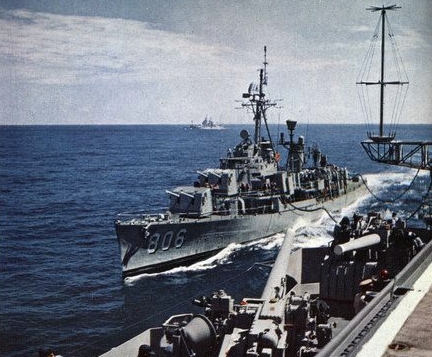
Higbee was from Bath Iron Works, commissioned on 27 January 1945. She sailed to Boston to be converted as radar picket, then for the Pacific on 24 May, and arriving with TF 38 off Tokyo Bay on 19 July. Nicknamed “Leaping Lenah” she screened the carriers for the last raids until 15 August, latr clearing mine fields, supporting occupation forces and back to San Diego on 11 April 1946. She later took part in fleet exercises, tactical maneuvers off the West Coast. In her second deployment she screened the heavy cruiser Toledo (CA-133) and made state visits to India and Pakistan in 1948.
Redesignated DDR-806 she sailed out on 18 March 1949 and soon was mobilized to join Korea with the 7th Fleet. She screened TF 77 and was detached on 15 September for the bombardment group at Inchon, back home on 8 February 1951. She made two more deployments in Korea, and patrolled the Formosa Straits. Back home on 30 June 1953, she was overhauled at Long Beach. Next she made several six-month WestPac cruises and back home, some training off San Diego. She visited Austrlia-NZ and trained with SEATO navies. She was homeported to Yokosuka, by May 1960 and returned to San Francisco on 4 September 1962, having later her FRAM I overhaul and was redesignated DD-806 by June 1963.
On 3 January 1964, after some training the returned to HP Yokosuka for her several Vietnam tours of duty. She was present during the Gulf of Tonkin Incident in August, while screening TF 77 in the South China Sea. She covered the 9th Marine Brigade at Da Nang. She was detached for the Gemini recovery also. On 1 September Higbee she rescued the crew of French Tanker Arsinoe grounded off Scarborough Shoals. She patrolled South Vietnam, becale a Station Ship Hong Kong, was overhauled at Subic bay, sighted the Soviet hydrographic ship Gidrifon. 17 June saw her sailing back to Long Beach, new HP by 2 July. November 1966 saw her hosting Bob Hope while offAcapulco, Mexico. 1967 her her overhauled at Mare Island and back in Vietnam . On 19 April 1972 she was bombed by two VPAF MiG-17s from 923rd Fighter Rgt, having a 250 kg (500 lb) bomb destroying her rear 5-inch gun mount. The other bombed the light cruiser USS Oklahoma City, but with light damage. She was repaired in the Philippines. The cruiser USS Sterett allegedly shot down one of the Migs.
In peacetime USS Highbee joined DesRon 27 in Long Beach and post May 1975 she entered the Naval Reserve Force, also based at Seattle with DesRon 37. In 1978 she won the trophy for best Naval Gunfire Support in the USN, gaining the cover of Surface Warfare magazine. She was decommissioned, stricken on 15 July 1979, sunk as target on 24 April 1986 off San Diego. She won a single battle star for WW2, 7 for Korea.
 USS Benner (DD 807)
USS Benner (DD 807)
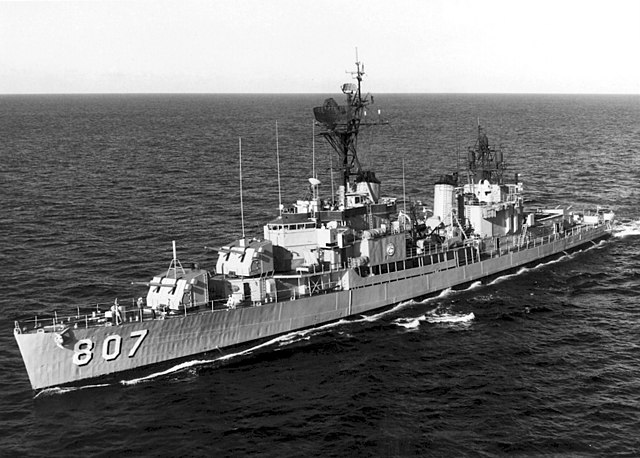
The destroyer was the first named for Marine Second Lieutenant Stanley G. Benner (1916–1942) killed at the Battle of Guadalcanal. Built at Bath, Maine, she was commissioned at Boston on 13 February 1945. Earmarked as picket ship she was modified between 13 February and 21 March, trained off Cuba, and after shakedown exercises weht to Haiti, for ASW training, Culebra Island, ASW patrol, Boston for post-shakedown availability, Norfolk, and screening Prince William (CVE-31) and Gantner (APD-42) to the Pacific after a stop in San Diego on 15 June 1945. She sailed wit USS Terry (DD-513), escorting USS Wasp (CV-18) as part of TU 12.5.3 off Pearl Harbor on 12 July for the last raids on Wake. After a stop at Eniwetok she joined TF 38 for the last raids on the home islands on 26 July.
She screened USS Randolph (CV-15), TG 38.3 on 28 July against Maizuru and the Tokyo-Nagoya area. She weathered a typhoon in early August, and resulmed operations over northern Honshū on 8 August. She took a picket position 50 miles (90 km) SW TF 38 with USS John W. Weeks (DD-701), Borie (DD-704) and Hank (DD-702), observing moves and vercoring CAPs, attacked at 14:54 by a single Aichi B7A1 “Grace”, helped splashing her out, but she hit USS Borie. She stayed for her in support all night.
She stayed on 10 and 15 August, was detached on 24 August off Nagoya and surveyed Tokyo and Okinawa. On 4 September, she joined CV-20 off Honshū for POW-relief flights until 9 September. She sailed to the Marshall Islands and back in Japan for occupation duty.
She left on 3 January 1946 for a wesPaci cruise, visit of Guam, Saipan, Philippines and back home to San Diego on 11 April. She was awarded a single battle star for her WW2 operations and had an overhaul at Terminal Island until 23 November 1946, making another deployment. She left with USS Dennis J. Buckley (DD-808) for Hong Kong and patrolled the East China Sea during the Chinese civil war, stopping at Shanghai, Tsingtao, Chinwangtao, Pusan.
After 11 months of local operations she sailed back to Asia on 1 October 1948 as the Pacific Mobile Striking Force, heading for Tsingtao. She was in local operations by 1949. She served still as radar picket, modernized as DDR-807 by 18 March 1949 but was reassigned to the Atlantic Fleet on 1 May, HP Newport. She served with DesDiv 102 and made three reserve training cruises, making a bilateral amphibious landing exercise with the RCAN off Labrador.
After an overhaul at Norfolk she made the first of many Mediterranean deployments on 2 May. She stopped in Lisbon, Elba, Naples, La Spezia but was recalled after the war broke up in Korea. Staying still in the Mediterranean for three months and visiting Istanbul, Beirut, Argostoli, and back to Newport on 10 October 1950. She made tw more Mediterranean deployment in 1951 and until 4 February 1953, then until 28 September 1954, visiting Spain, France, Italy, Greece, and Turkey but also Algiers and Tangier. Back home she performed reserve and midshipmen training and NATO training plus a sweep beyonf the Arctic Circle for Ops. “Mainbrace” and “Longstep”.
After an overhaul at Philadelphia in 1955 she took part in “LantFlex 1” (amphibious exercise, Newfoundland) and another Med Cruise. She trained in the Gulf of Mexico and had a modernization at New York Naval Shipyard, Brooklyn until May 1956.
Sge was reassigned to the Pacific that year, reporting to Long Beach, joining DesDiv 91 on 26 August for six months refresher training and a WestPac with the 7th Fleet. She visited Australia, stopped at Manus and Guam, Yokosuka, patrolled the Taiwan Strait, stopp at Kaohsiung, Keelung, Hong Kong and back to Long Beach on 10 September.
After local Ops she had an overhaul, a refresher training and departed on 29 April for the Marshall Islands and “Operation Hardtack I” (atmospheric nuclear tests) also coordinating air operations center functions at Bikini Atoll. After weeks of screening carrier operations off Okinaw she returned to Taiwan, dealing with Communist artillery and for the Quemoy crisis.
She made another tour and back on 26 November.
After another overhaul at Long Beach and FRAM overhaul she resumed operations from April 1965, joined DesDiv 232 to screen USS Hornet (CVS-12) off San Diego and cruised with midshipmen off Puget Sound. She departed on 12 August, for a six-month TOD in Vietnam. She joined TF 77 for naval gunfire support off Quang Ngai, SAR in the Gulf of Tonkin and patrols at Kaohsiung than trained with the ROK Navy and retired to Sasebo for XMas leave. On 3 January 1966 she retruned to the Taiwan Strait. She was soon back home. She made another 3 months Vietnam Tour and back in Hawaiia took part in the “Golden Plunger Award”, sinking USS Plunger (SSN-595) in exercise. Back in Vietnam she took part in “Operation Sea Dragon”.
On 26 February 1967 she joined USS Canberra (CAG-2) and Joseph Strauss (DDG-16) for shelling the North Vietnamese coast, dealing with two counter-battery actions notably at Hon Matt Island. In all she spent 1,281 rounds. She patrolled the Taiwan Strait and was back to Long Beach in May. In 1968 after ASW training she returned to the Far Easter via Yokosuka as gunfire support ship notably in the Vũng Tàu area for “Operation Game Warden” and patrolled the DMZ.
With TF 77 by August, she took part in “Swift Move” and after as top in Japan returned in the Gulf of Tonkin, and left for Long Beach in November.
January 1969 saw her as a tender to submarines Bugara (SS-331), Charr (AGSS-328), Medregal (AGSS-480) and Bluegill (AGSS-242), followed by an overhaul. On 30 July she had a fuel oil fire in her after fireroom, later under control. This was attributed to badly setup electrical cables. She later also lost her remote-controlled DASH at sea.
After inspections, tender availability, she returned to the Far East via Pearl Harbor, Midway, Yokosuka, and bacl at “Yankee Station” on 13 November, used as plane guard, ASW screen during raids on Laos, South Vietnam and Cambodia and escorting USS Long Beach (CGN-9) and USS Ranger (CVA-61).
After Benner returned home on 9 April, she fell victim to the drastic defense infrastructure budget cuts of the time to fund the war in Vietnam. Reporting to the Puget Sound Naval Shipyard in She was inactivated at Bremerton on 29 August, decommissioned on 20 November 1970, stricken on 1 February 1974 but not sold to South Korea and sold for scrap to General Metals of Tacoma on 18 April 1975. For her WW2 service she won a single battle star, 5 for Vietnam.
 USS Dennis J. Buckley (DD 808)
USS Dennis J. Buckley (DD 808)
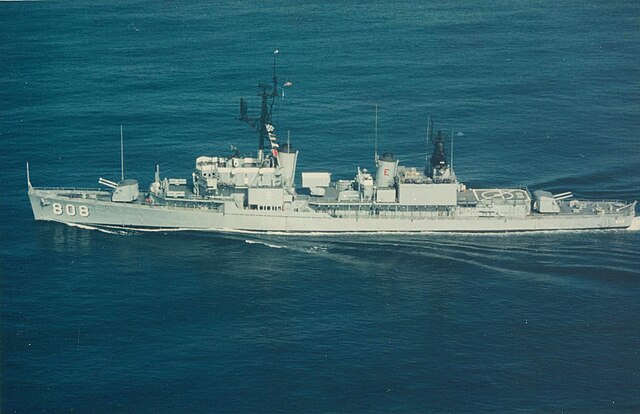
Dennis J. Buckley was built at Bath Iron Works Corp. commissioned on 2 March 1945. She left Norfolk on 7 November 1945 for occupation duty in Japan, arriving at Tokyo Bay on 22 December. Next she sailed to the Marianas and Manila, then back to San Diego on 13 April 1946. She woould return to the Far East in 1947, cruised off China and took part in exercises off Okinawa. On 1 October 1948 she sailed to Tsingtao and patrolled the strait during the evacuation of civilians during the civil war. She teamed with USS Tarawa (CV-40) and Hawkins (DD-873) via Hong Kong and Singapore to Colombo, anf then the Persian Gulf, via Bahrein and Jidda, Port Said, and the Med, Athens, and Istanbul, then back to New York (22 February 1949) for their first round-the-world. USS Dennis J. Buckley was in operations on the west coast after crossing the Canal in May and left the Caribbeans, being reclassified as radar picket DDR-808, by March 1949 and reassigned to the eastern seaboard (Norfolk-Argentia) and returned to the Mediterranean, 6th Fleet. From April to October 1951 she made a cruise to northern Europe, (Plymouth, Weymouth, Bremerhaven, Antwerp, Cork, Derry).
Between 1952 and 1955, she made three tours of duty in the Mediterranean and in between became engineering school ship for officers, plus exercizes in the North Atlantic, Gulf of Mexico. She was not deployed in Korea.
1 May 1956 saw her back to the Pacific Fleet, Long Beach, for another westPac and back on 21 October. In 1957 she screened USS Princeton (CV-37) off Taiwan and became flagship for the Destroyer Flotillas in western Pacific, visited by CNO Arleigh A. Burke. She returned to a WestPac cruise by 23 August 1958, with TF 72 ensuring the Quemoy Islands would not be seized by China. She was back on 27 February 1959. She returned to the Pacific on 15 October until 11 March 1960, had an overhaul and resumed west coast duty.
Long sttory short, she had her FRAM I coverhaul, and served in Vietnam. On 2 July 1973, she was decommissioned, stricken mothballed in the Naval Inactive Ship Maintenance Facility of San Diego. On 29 April 1974 she was sold for scrap.
 USS Myles C. Fox (DD 829)
USS Myles C. Fox (DD 829)
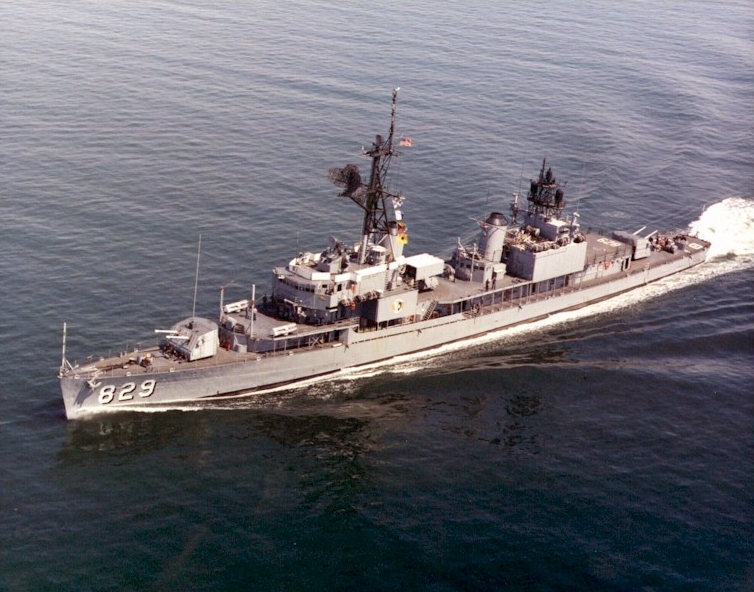
The destroyer was named for Myles C. Fox, a USMC lieutenant posthumously awarded the Navy Cross in this war during the seizure of Tulagi. Her namesake was built at Bath Iron Works Corp. commissioned at Boston on 20 March 1945. After Caribbean shakedown, training off New Jersey she was ready for service by 5 July 1945, heading for the Panama Canal, tne San Diego, Hawaii, arriving on the 28th. She departed on 10 August to the Marshalls for the final Operation Downfall/Olympic which was cancelled as she was underway on 15 August. She stopped at Eniwetok, and arrived at Tokyo Bay on 9 September, screening carriers until sailing for Saipan on 8 January 1946. On 25 March she went home to HP San Diego with veterans aboard. After west coast operations she returned to thge far east in early 1947, Yokosuka and operated off Korea, China, Okinawa, Hong Kong.
She rescued the crew and passengers of SS Hong Kheng running aground at Chilang Point (Hong Kong) with other ships.
She was back to San Diego on 8 October. After overhaul, she made another WestPac from 2 October to 23 December 1948 with the fast carrier forces. Back home she was homeported to Newport, Rhode Island and redesignated DDR-829 on 18 March 1949.
She was deployed in the North Atlantic and by May 1950, the Mediterranean, 6th Fleet, visiting France, Italy, Turkey, Yugoslavia, Greece, Spain.
After fixes at New York and convoy exercises, tactics at the Virginia Cape until March 1951 when she was back at Gibraltar on 6 April and to Newport by 4 October.
On 26 August 1952 with she screened USS Midway (CVB-41) and Franklin D. Roosevelt (CVB-42) to Greenock in Scotland for exercizes in the Norwegian Sea with NATO force. She stopped later at Lisbon for another tour with the 6th Fleet and back in February 1953.
On 8 June 1953 she made a midshipman cruise down to Brazil-Colombia. She stayed the next year on the east coast-Caribbean, missing the Korean war and was back in the Med on 2 May 1955 for three months. This repeated the next years. In 1961 she won a Battle Efficiency “E”. In 1964 she was homeported to Boston, having her FRAM I overhaul, back to DD-829 in April 1965.
By July 1965, she had a catastrophic fire in her Radio Central, was repaired at Boston and sent to quell an insurgency in the Dominican Republic, earning an Armed Forces Expeditionary Medal. 9 August 1965 saw her back to the Mediterranean and she was assigned to Gemini 8 recovery, eastern Atlantic.
She helped the Swedish freighter M/V Palma on fire.
Back on the east coast she performed DASH qualifications and was sent to the Far East on 4 October via Panama, Hawaii, Japan, Philippines, and to North Vietnam on 7 January 1967 for a serie of fire support missions, also sinking smuggling junks and sampans. She made another round-the-world cruise back to Newport on 25 April 1967. On 26 September she had an overhaul until January 1968 at Boston, DASH removed. After a Cuban refresher training she was back in the Mediterranean by October. January 1969 saw her in the Apollo 11 program off Virginia. She was deployed in the Indian Ocean and back by September 1969.
She was off Cuba by 1970 and UNITAS XI (South America) in extensive training. She was back to Newport on Dec 1970. 12 March 1971 saw her overhauled at Boston and she departed for the Middle East on 7 Jan 1972, 4 months. 2 May 1972 saw her back to Viet Nam for 2 months of naval gunfire support and another Battle Efficiency “E”, back in Newport in August.
In June 1973 she was converted to fuel oil distillate and was versed to the Naval Reserve Force, homeported to Brooklyn, NY. 1973–1979 saw her training Naval Reserve and by February 1978 off Cuba. She was assigned various duties for the 2nd fleet until decommissioned on 1 October 1979, sold to Greece in 1980, cannibalized for parts until scrapped in 2003.
 USS Everett F. Larson (DD 830)
USS Everett F. Larson (DD 830)

USS Everett F. Larson was built at Bath Iron Works, commissioned on 6 April 1945. On 1 August 1945 she sailed for the Pacific, learning underway about V-Day and arriving on 29 September at Tokyo Bay for occupation duties. She covered the landing of Marines at Taku in China by October 1945 and took part in Operation “Road’s End”, sinking 24 captured Japanese submarines, April 1946. She was back home HP San Diego on 21 December, but homeported to Rhode Island, 19 March 1947.
She spent many years in the Atlantic Fleet (seven tours, 6th Fleet, Mediterranean), watching over the Palestine partition, NATO exercizes until 1955, ASW exercizes off the east coast, Caribbean training. June 1956, saw her HP back to Long Beach, California for Pacific Fleet service, training from California to Seattle, and deployed in 1957, 1958, 1959, and 1960 between Taiwan, Okinawa and the Philippines, plane guard for TF 77 and in 1958 was seen at Pago Pago and Auckland.
She took part in the 1960 annual “Great White Fleet Review” in San Francisco Bay. Jun, 1962 saw her overhauled at Long Beach as FRAM II. Back from Radar Picket Destroyer she became an ASW bmarine destroyer, DD-830, recomm. on December 1962.
In April, 1963 she joined DESRON 23 (former Admiral Arleigh Burke unit in WW2) and DESDIV 231 in it. 27 August 1965 saw her in the gunline off North Vietnam, resupplied by USS Bennington (CV-20) and Hassayampa (AO-145) and as plane guard. She had another refit at Long Beach Naval and after local operations into March, including HUKASWEX (Hunter Killer Anti-Submarine Exercise) with group 5 she made another WESTPAC by 9 June 1966. She sailed first to Yokosuka on 14 July 1966. Deployed to “Yankee Station” she patrolled off Kaohsiung and Keelung (Taiwan) and back to “Yankee Station”. She took part in operation “Silver Skate” in September and returned to gunfire support, sending 656 rounds.
After upkeep at Subic Bay, she returned to “Yankee Station” until some R&R at Hong Kong by October 1966, then Kaohsiung, Taiwan patrol and back to Yokosuka and back home for Xmas 1966.
She was back in 1968 on “Yankee Station”, as plane guard, ASW patrol, and present during the USS Pueblo’s capture with DESRON 23, assigned to TF 71, and in Operation Formation Star.
After refit in Sasebo she was back in the Sea of Japan, plane guard with USS Canberra (CA-70) and back home in March-April.
She spent the rest of the year off Southern California for training.
May-June had her overhauled at Long Beach, in HOLDEX 4-68 in July and fire tested the MK 46 towed target, hit by a Dash torpedo.
After ASW operation with ASW group 1 she departed departed Long Beach in March with DESDIV 231 for deployment off Taiwan, Okinawa, Philippines and gunline off North Vietnam, screening TF 77.
In late May 1969, she took part in SEATO Exercise Sea Spirit and assisted HMAS Melbourne but nearly collided with her on 31 May. Frank E. Evans (DD-754) was later rammed and sunk by the carrier and she assisted in the rescue.
USS Everett F. Larson was eventually decommissioned in August 1972, transferred to the Korean Navy as ROKS Jeon Buk (DD-916) by October 1972, decommissioned in December 1999, museum ship at Gangneung Park but due to COVID and declining funds she was BU by December 2021.
 USS Goodrich (DD 831)
USS Goodrich (DD 831)

USS Goodrich was commissioned on 24 April 1945. After shakedown in the Caribbean, she crossed the Panama Canal on 12 November to take part in occupation duties in Japan until October 1946; she visited Tsingtao, and patrolled the coast of Korea. She was back to San Francisco, 21 December 1946, departed again on 7 January 1947, HP Newport, Atlantic Fleet.
After overhaul in New York she made several tours in the Mediterranean, the first between 2 February and 22 May 1948 with the 6th Fleet.
She debacme radar picket destroyer (DDR-831) on 18 March 1949 and patrolled over the Israeli-Egyptian Red Sea dispute by February 1956 (Suez crisis) and in November 1956 to protect US citizens. She covered the landing of Marines at Beirut on 14 July 1958.
By June 1959 she was homeported to Mayport, and in between Med Tours, was involved in heavy training with NATO fleets, and the 6th Fleet. January 1960, saw her overhauled at Norfolk, FRAM II modernization. She took part in project Mercury recovery in February 1962.
From 24 October to 20 November 1962 she took part in the quarantine of Cuba during the missile crisis. On 22 July 1966 she departed for her 13th Med deployment, training with Turkish, Greek, British, and Italian Navies and back on on 20 December 1966 for upkeep and type training.
Reclassified DD-831 on 1 January 1969, she was eventuallty decommissioned on 30 November 1969, staying at Orange, Texas, until stricken on 1 February 1974, sold for BU on 12 September 1977.
 USS Hanson (DD 832)
USS Hanson (DD 832)
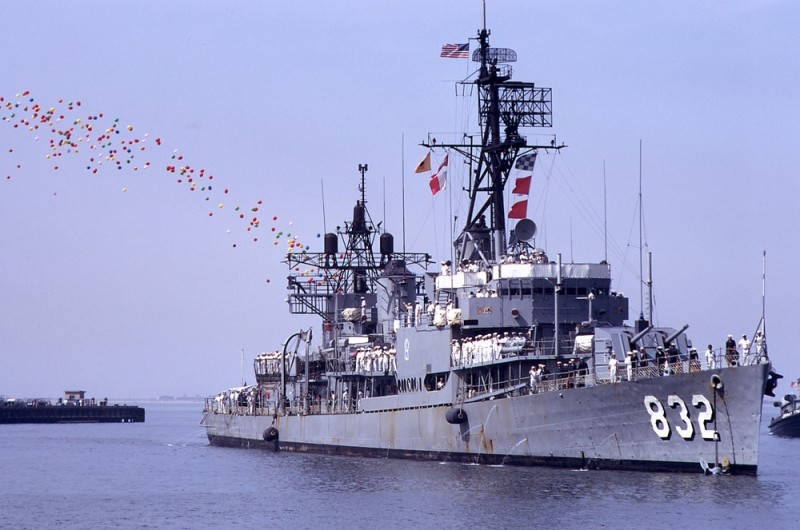
USS Hanson back home, San Diego, on 4 August 1971. She became one of the most decorated Gearing class DD in Vietnam ever.
USS Hanson was commissioned 11 May 1945. She had one of the longest and most interesting career of all Gearings. After Caribbean shakedown she was converted to a picket destroyer at Boston and was not able to proceed in the Pacific before 7 November 1945, missing the last raids on Japan, but right on time for occupation duties like most Gearings. She weathered a typhoon lasting four days and was repaired at Yokosuka. Occupation duties were interrupted by fleet maneuvers off China.
She was reassigned to the Atlantic Fleet, returning via Norfolk on 6 February 1947, trained on the East Coast and by late January 1948 departed for the 6th Fleet and Mediterranean as DDR-832 on 8 March 1949. The summer of 1949 saw her as UN station ship off Rhodes, and she landed the mediator Dr. Ralph Bunche to Beirut. HP to Newport, in January 1950, she returned to the Sixth Fleet, with USS Midway Carrier Battle Group, with two cruisers, notably USS Newport News and twelve destroyers for a 3rd Mediterranean deployment. She stopped in Spain, Libya, Italy, France, and Greece. She was back home on June 1, 1950, homeported to San Diego and rescheduled to sail to Korea, going straight to Pearl Harbor and T.F.77 to Pusan.
She became there plane guard, detached for shore bombardment missions and radar picket. She took part in the landings at Inchon on 15 September 1950. She then resplenished at Sasebo, and was back to Korea, covering the evacuation of Hŭngnam and Wonsan. This year, she had sail continuously for 254 days. By mid-January 1951 she was back in Sasebo and San Diego in April.
For her second deployment to Korea (September 1951 – May 1952) she shelled shore targets in support of ground troops notably at the Chosin Reservoir, and screened TF 77, detached for a strike in Hŭngnam harbor with USS Helena, destroying railroads. Her gyro failed and she was replaced by Earnest G. Small but the later struck a mine and lost her bow, going to Sasebo by sailing astern. Hanson hunted down minelayers disguised as fishing vessels and on 22 October 1951, saved the crew of an AD-4W. She took part in the Formosa Patrol had R&R at Hong Kong but was struck by a huge typhoon before being back to Korea. She covered US Army rangers with gunfire support. She took part in Task Element 95.11, with RCN Athabaskan (R79) and Charity (R29), USS Badoeng Strait in the Wonsan area.
She left for San Diego by May 1952 and back in Korea in December 1952, covering the fast carriers, then back on 20 July 1953 after the Pan Mun Jon Armistice. She made other peacetime 7th Fleet deployments with tactical maneuvers, battle exercises but returned to hot points such as Formosa fall 1958, and Quemoy-Matsu. She took part in the celebration of the battle of Coral Sea in Austrlia. April 1964 saw her back as DD-832 converted to FRAM I at San Francisco Naval Shipyard until 6 December 1964. In 1965 with DesRon 11, she made the first of several deployments in the Vietnam War. July saw her in shore bombardments. She was back for a second tour on 17 July 1966, anchored in the Saigon River on 13 September, and until 6 January 1967. She spent 9,000 rounds at NVA targets, added to her plane guard, patrols, SAR and refuelling helicopters.
She had a long overhaul at Long Beach before a 3rd Vietnam tour (March to September 1968) taking part in the “Pueblo crisis” off North Korea, Operation Formation Star. She was also one of the first shelling North Vietnam. Back on San Diego in September she departed for her 4th tour on 23 June 1969 with USS Dennis J. Buckley and Hull, screening for USS Hancock and TU 17.4.2. She joined TG 77.4 at Yankee Station and Naval Gunfire Support. She went to Da Nang Harbor for replenishment and returned to Point Allison.
January 1970 saw her in TU70.0.3. back to San Diego and she had a refit at Hunter’s Point Shipyard in San Francisco however on 21 August 1970 a flooding due to a cracked water main. During her shakedown a fire broke out in a boiler room, the crew battling fire for eight hours and she was repaired in San Diego. After some training she joined TU54.l.l on 18 December. She departed on 5 February 1971 for another 6-month deployment in Vietnam. She was deployed from Da Nang, but also visited Bangkok, Okinawa, and Hong Kong.
She spent a week in gunfire support. While off Subic Bay, she stumbled upon Soviet Riga Class Frigate 807.
On 26 April, she sailed to Pusan, later Sasebo but later crossed Soviet fleet tugs towing dry docks and on 6 May 1971, collided with one. A film was made of the international incident, third collision before the Sea Agreement of 1972. She was back in VN for a last TOD, including naval gunfire support, plane guard duty at Yankee station, Tonkin Gulf and observing Soviet vessels before heading for San Diego.
While back she had an extensive electronic upgrade, the SAMID Immediate Package Program. She sailed out for another Vietnam tour on 10 April 1972, which was the most engaging wartime effort. Over the Philippines she was flew over by a Soviet Tupolev Tu-95 “Bear” at low altitude. From Subic Bay, she was moved to Tonkin Gulf with additional M2 Browning HMGs mounted on the bridge wings but also rockets and shoulder-launched Redeye SAM to fend off MIG attacks after the Battle of Đồng Hới on 19 April.
She was back in Tonkin Gulf, sailed to North Vietnam and took part in Operation Freedom Train (“Operation Linebacker”) shellking targets in the Haiphong area on 4-9 May 1972 and Operation Custom Tailor on 9–10 May at Do Son Peninsula in Haiphong. She was joined by USS Providence and Oklahoma City and slicenced shore batteries. Raids went on in June and she took part in Operation Song Thanh (6-72) as well. She took hits near Hon La and Hon Mat islands. 29 June 1972, saw her at Quảng Trị in support of SVA Marines and USMC 9th MAB for Operation Lam Son 72 I. In July she supported the 1st VNMC Division and ARVN 3rd Division.
But she lost her main gyro and steering, sent for repairs at Subic Bay and back on the DMZ. By 8 September she was relieved by USS Hollister and became plane guard for USS Midway but called again on 13 September, at Chu Lai in support of the ARVN, but struck by typhoon Flossie. She earned a Meritorious Unit Commendation. She made another support on 17 September 1972, and later at Mộ Đức her gunfire guided by an OV-10, saving ARVN soldiers. On 1 October, she supported the 11th Ranger group at Mộ Đức and later sailed for more surface raider strikes north of the DMZ.
She had some R&R at Hong Kong and made her journey home with Hull and Dennis J. Buckley via the Philippine, Guam, Pearl Harbor, San Diego in November 1972. Decommissioning preparation started right after. She was stricken on 31 March 1973 but transferred to the Republic of China on 18 April as Liao Yang (DDG-921). She spent an additional …31 years of service before decommission on 1 June 2004 at Kaohsiung, sunk as a target.
 USS Herbert J. Thomas (DD 833)
USS Herbert J. Thomas (DD 833)
 USS Turner (DD 834)
USS Turner (DD 834)
(More to come)

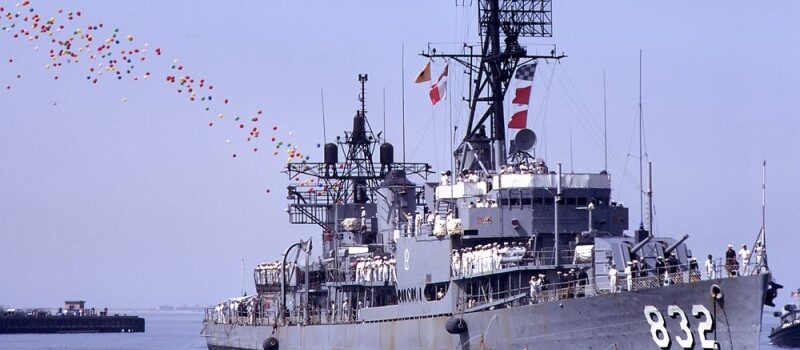



 Latest Facebook Entry -
Latest Facebook Entry -  X(Tweeter) Naval Encyclopedia's deck archive
X(Tweeter) Naval Encyclopedia's deck archive Instagram (@navalencyc)
Instagram (@navalencyc)





 French Navy
French Navy Royal Navy
Royal Navy Russian Navy
Russian Navy Armada Espanola
Armada Espanola Austrian Navy
Austrian Navy K.u.K. Kriegsmarine
K.u.K. Kriegsmarine Dansk Marine
Dansk Marine Nautiko Hellenon
Nautiko Hellenon Koninklije Marine 1870
Koninklije Marine 1870 Marinha do Brasil
Marinha do Brasil Osmanlı Donanması
Osmanlı Donanması Marina Do Peru
Marina Do Peru Marinha do Portugal
Marinha do Portugal Regia Marina 1870
Regia Marina 1870 Nihhon Kaigun 1870
Nihhon Kaigun 1870 Preußische Marine 1870
Preußische Marine 1870 Russkiy Flot 1870
Russkiy Flot 1870 Svenska marinen
Svenska marinen Søværnet
Søværnet Union Navy
Union Navy Confederate Navy
Confederate Navy Armada de Argentina
Armada de Argentina Imperial Chinese Navy
Imperial Chinese Navy Marinha do Portugal
Marinha do Portugal Mexico
Mexico Kaiserliche Marine
Kaiserliche Marine 1898 US Navy
1898 US Navy Sovietskiy Flot
Sovietskiy Flot Royal Canadian Navy
Royal Canadian Navy Royal Australian Navy
Royal Australian Navy RNZN Fleet
RNZN Fleet Chinese Navy 1937
Chinese Navy 1937 Kriegsmarine
Kriegsmarine Chilean Navy
Chilean Navy Danish Navy
Danish Navy Finnish Navy
Finnish Navy Hellenic Navy
Hellenic Navy Polish Navy
Polish Navy Romanian Navy
Romanian Navy Turkish Navy
Turkish Navy Royal Yugoslav Navy
Royal Yugoslav Navy Royal Thai Navy
Royal Thai Navy Minor Navies
Minor Navies Albania
Albania Austria
Austria Belgium
Belgium Columbia
Columbia Costa Rica
Costa Rica Cuba
Cuba Czechoslovakia
Czechoslovakia Dominican Republic
Dominican Republic Haiti
Haiti Hungary
Hungary Honduras
Honduras Estonia
Estonia Iceland
Iceland Eire
Eire Equador
Equador Iran
Iran Iraq
Iraq Latvia
Latvia Liberia
Liberia Lithuania
Lithuania Mandchukuo
Mandchukuo Morocco
Morocco Nicaragua
Nicaragua Persia
Persia San Salvador
San Salvador Sarawak
Sarawak Uruguay
Uruguay Venezuela
Venezuela Zanzibar
Zanzibar Warsaw Pact Navies
Warsaw Pact Navies Bulgaria
Bulgaria Hungary
Hungary

 Bundesmarine
Bundesmarine Dutch Navy
Dutch Navy Hellenic Navy
Hellenic Navy Marina Militare
Marina Militare Yugoslav Navy
Yugoslav Navy Chinese Navy
Chinese Navy Indian Navy
Indian Navy Indonesian Navy
Indonesian Navy JMSDF
JMSDF North Korean Navy
North Korean Navy Pakistani Navy
Pakistani Navy Philippines Navy
Philippines Navy ROKN
ROKN Rep. of Singapore Navy
Rep. of Singapore Navy Taiwanese Navy
Taiwanese Navy IDF Navy
IDF Navy Saudi Navy
Saudi Navy Royal New Zealand Navy
Royal New Zealand Navy Egyptian Navy
Egyptian Navy South African Navy
South African Navy






























 Ukrainian Navy
Ukrainian Navy dbodesign
dbodesign
Under Armament / Main:
since the destroyer leaders of the Porter and Porter class …: 2 times PORTER class ?
Thx for spotting, fix underway !